Australian
and international
exploratory
performance and
media arts
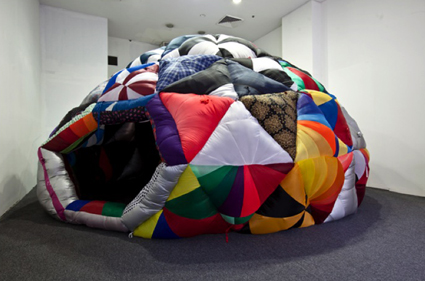
Impossible Utopia 2011, Keg de Souza
Keg de Souza describes herself as an “anarchitect,” an amalgam that comes closest to encapsulating her practice which involves architecture, environmental design and activism with a little bit of drawing, printing and bookbinding included for good measure. While her artworks take varied forms her central focus is on “spatial politics… not only the built environment, but the social space inhabited within” (Artist statement). De Souza is currently one of the 2013/2014 Early Career Creative Australia Fellows and as the projects below indicate, she’s making the most of it.
Space making
De Souza came on the scene in around 2000 when she was part of Squat Space, a collective running a gallery in one of the shopfronts of Sydney’s Broadway Squats. The inhabitants were receiving a lot of attention due to their organized and highly articulate battle to legitimise their tenancy. After they were evicted, the collective continued as a roving ARI producing a number projects including SquatFest, an underground alternative to TropFest, and Tour of Beauty, a bicycle and walking tour around Waterloo-Redfern talking with locals about the area (http://squatfest.com/history/).
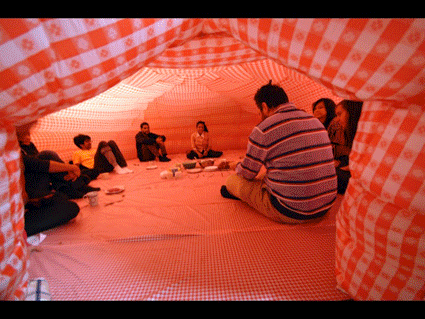
Gonflables et amuse-bouches 2012, Keg de Souza
courtesy the artist
Gonflables et amuse-bouches 2012, Keg de Souza
Inflatables & edibles
This interest in space and community building has recently manifested in the form of large inflatable structures. De Souza says, “Inflatables were just naturally a way for me to be able to make something that was easily transportable. I was also thinking about utopias and nomadic architecture and the history of inflatables. They were often used as a symbol of radical architecture. There was a big show in Paris in 1968 by the Utopie group that showcased a lot of work by artists, architects and activists who used inflatables in their practice, such as Ant Farm and Haus Rucker Co. But also I was thinking about what they can encompass [now] with their temporality.”
In 2012 de Souza undertook a residency at the Darling Foundry in Montreal where she created the work Gonflables et amuse-bouches which incorporated elements of food and mapping. She says, “In Montreal I was pretty taken aback by these radical activist kitchens that worked out of the two main Anglophone universities there—McGill and Concordia. These radical kitchens cook for the students everyday but they also cater for activist events…The inflatable was constructed out of disposable plastic tablecloths and I had a series of events inside it [and outside while it was being constructed] that explored food and the way it intersects with art, architecture, radical spaces and radical organising. I guess it was a way to encompass all these interests—[to see] how they can intersect and create this dialogue about communities.”
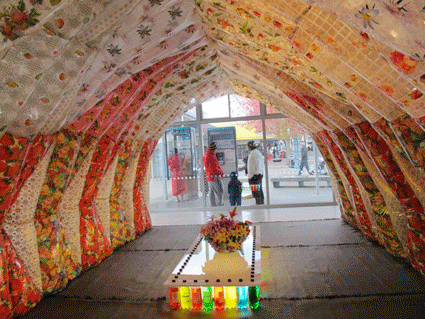
Tropical Thunder 2013, Keg de Souza
courtesy the artists
Tropical Thunder 2013, Keg de Souza
Local mapping
De Souza has continued this line of thinking in Tropical Thunder, part of the 2013 Auckland Triennial. She was based at Fresh Gallery, Otara in south Auckland, a suburb with a 70% Pasifika population: “Everything in that town centre was geared towards a Pasifika community. So out the front of supermarkets they had coconuts, green bananas and taro for sale…This continued into the $2 shop. In the $2 shop in Redfern you might see plastic flowers—sunflowers or roses—but in Otara there were frangipanis and hibiscus. Everything was tropical including material that had Pasifika patterns. But it was all made in China. I thought it was really interesting how this culture had been commodified and commercialised overseas, then all these mass-produced items from China were sold back to the culture that they were appropriated from.”
In Otara, de Souza made her inflatable out of Pasifika themed plastic tablecloths following the design of the canopy that arches over the town centre. She held sessions inside the structure with local community members and created a food-centric map of the area: “I gathered additions and comments to this map about what the locals wanted to say about food, whether it be a place to eat or a personal story, or [particular] legislations…So this created a local knowledge food map of the area.”
I asked de Souza about finding a balance between artistic and social outcomes. She is emphatic: “I’m always really clear when I do these socially driven projects that I am an artist. And I’m really clear about what I’m exploring to begin with. [But] there’s a lot of risk taking. You can’t go into a community expecting a particular outcome… [it’s only] when you meet the people—that’s what really shapes the project.”
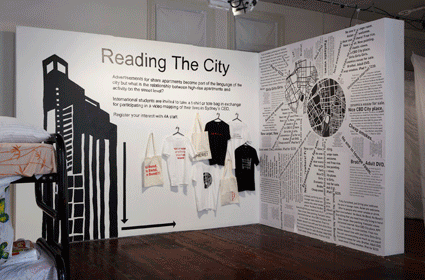
ruangrupa ArtLab and Keg de Souza, Vertical Villages, Haymarket (2013) (installation view, 4A Centre for Contemporary Asian Art, Sydney). Commissioned by 4A Centre for Contemporary Asian Art.
courtesy 4A and the artists, photo Zan Wimberley
ruangrupa ArtLab and Keg de Souza, Vertical Villages, Haymarket (2013) (installation view, 4A Centre for Contemporary Asian Art, Sydney). Commissioned by 4A Centre for Contemporary Asian Art.
Collaborative cultures
De Souza’s most recent project, Vertical Villages, facilitated by Sydney’s 4A Centre for Contemporary Asian Art, is a collaboration with Indonesian artist collective ruangrupa ArtLab. Together they have been consulting the international student population of the CBD, exploring their micro-culture of self-organisation and redesign of urban living spaces. These students often live in city apartments with multiple occupants in the one room, creating a little slice of private domestic space out of a bunk bed with a shower curtain for privacy. The exhibition, currently still running, combines an installation of these compact living spaces complete with domestic clutter of food stashes, toiletries and TV screens showing videos made by students. There’s also a large map in which students are invited to add their own comments and suggestions for exploring the city. Students have also been invited to program House Parties—Friday night activities in the gallery.
De Souza says of this collaborative process, “I guess our practices have a lot of crossover in terms of themes—cities and space. Obviously our outcomes are really different and our aesthetics, but those processes of dialogue and gathering information [are similar]. With the outcomes here we were pushing each other to do things slightly differently. I don’t look at the show and go this is definitely ruangrupa, this is me—maybe in aesthetics—but in the process all those things were really driven together.”
Part two of Vertical Villages will see Keg de Souza joining ruangrupa in Jakarta where they will work with local migrant worker communities with the outcome exhibited as part of 15th Jakarta Biennale.
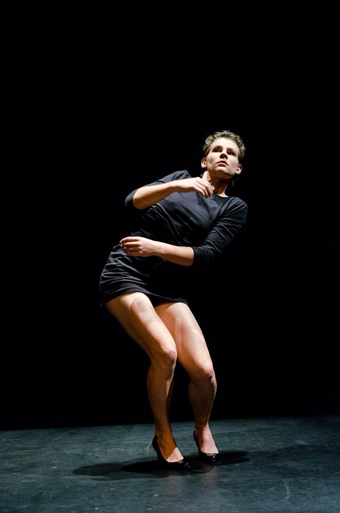
Miranda Wheen, Quest
photo Heidrun Löhr
Miranda Wheen, Quest
Miranda Wheen is one of those dancers with an ineffable quality that makes them utterly compelling, your eyes constantly drawn to them amongst other dancers on stage. Such performers shine in any work, but they positively shimmer when matched with just the right choreographer.
All in the detail
Most recently Wheen has been shimmering in the extended and complex solo Quest, choreographed specifically for her by Martin del Amo. The work was originally commissioned by Chronology Arts and Dirty Feet in 2012 and has recently been reprised by the commissioning companies for the Vitality season at the Seymour Centre. A week later it formed part of del Amo’s Little Black Dress Suite at Riverside Theatre presented by Form Dance Projects.
Quest is a slow and intense work in which Wheen is always in control of minute muscle shifts, trembles and tensions, until she explodes into a confused, but somehow still elegant flailing. Performed to an angular composition by Alex Pozniak, it is an exacting work for both performer and the audience but rewards with its obsessive accumulation of detail and rigorous shaping. Del Amo’s idiosyncratic choreography, initially so interlinked with his own performance, is developing in interesting directions in the hands (or bodies rather) of strong interpreters, of which Wheen is definitely one.
Cross-cultural relations
A distinctive aspect of Wheen’s career so far has been her involvement in inter-cultural collaboration. She travelled to Senegal in 2007 to study under renowned African choreographer Germaine Acogny (http://www.jantbi.org/spip.php?rubrique6). In an email interview Wheen says of this experience, “Dancing for two months in Senegal significantly changed the way I felt when I danced. It was a lesson in setting physical information aside for a time in order to let new things enter and be absorbed into the body. I think a successful intercultural collaboration is constantly in flux; you are at the same time an expert and a novice.”
Game On (2011) was a collaboration between choreographer Annalouise Paul and renowned classical Indian tabla player Bobby Singh. Wheen says, “I was lucky enough to work with Bobby Singh over a period of six or seven years on a number of projects. Like any good friendship, a good collaboration can transcend the sensitivities and politeness of working across multiple cultural histories.” Keith Gallasch commended the balance of this relationship in a review of the show: “Wheen met Annalouise Paul’s considerable choreographic challenge and Singh’s rhythmic demands with total fleet-footed commitment…The response to rhythmic change was never literal, neither artist simply speeding up because the other was moving or playing faster, instead producing a marked visual or sonic counterpoint.” (RT105 online).
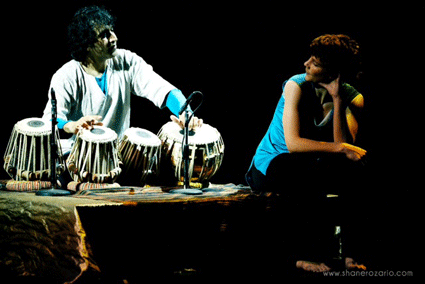
Bobby Singh, Miranda Wheen, Game On
photos Shane Rozzario
Bobby Singh, Miranda Wheen, Game On
Most recently Miranda Wheen has been in Broome working with Marrugeku on their Listening to Country Laboratory. Wheen says, “I love working in intercultural collaborations. They have taught me a deep appreciation for the infinite ways of knowing, learning and communicating culture and the necessity of careful cultivation of relationships, which inevitably take time and constant re-evaluation. The major difficulty with a lot of these projects is that they often feel like the tip of the iceberg. Working with a company like Marrugeku in Broome is inspiring because of their commitment to collaboration simply taking time. With Marrugeku, while the work remains central to the process, things like family, community, country, food and story are very much important elements to the process.”
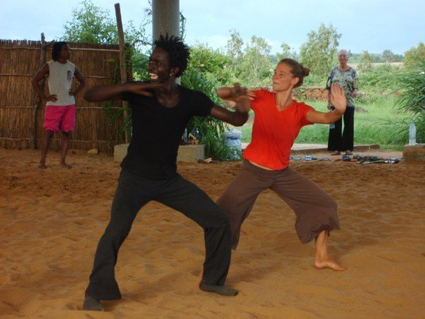
Ecole des Sables in Senegal
photo Jamo Mweu
Ecole des Sables in Senegal
Internal motivations
While Wheen definitely is still in her dancing prime, it’s almost inevitable that she is going to want to explore her own dance language sooner or later. I asked her about where she sees her practice heading. “I’m not sure whether I’m moving away from being a dancer, but I’m certainly deriving more and more pleasure from creating work for myself. As an independent dancer I am involved in quite a diverse range of projects and collaborations with many different people and processes. I think you have to be constantly prepared to work beyond your existing skills and experience, so a lot of new information is constantly flowing into my practice. I guess turning to creating my own work is about sifting through all that information and giving myself time to linger on a particular interest or idea.”
We will have an opportunity to see Wheen’s choreographic vision in October when she and nine other dancer/choreographers—the Dance Makers Collective—present Big Dance in Small Chunks through Form Dance Projects. For this Wheen will be making a work that takes as its starting points the corrupt NSW politician Eddie Obeid and the pelvis. I ask how these two ideas connect. Wheen replies, “After my time in Senegal I developed an interest in the internal lineage of movement that existed in my body when I danced, in particular movement that was driven by the pelvis. The movement that emerges when thinking about my pelvis is very internally motivated, as if the pelvis is the conscious centre of the body—what is driving the dance. Of course the importance of the pelvis is by no means a new concept to modern/contemporary dance practice…Recently I have been struck with the concept of the ‘faceless men,’ the expression used to describe scheming back-room New South Wales politicians such as Eddie Obeid. This pelvic-driven movement I’ve been working with seems to have a quality that resonates with this idea of ‘facelessness,’ that the conscious or expressive centre of the body is not the face. What if Eddie’s expression of self was not in his face but in his pelvis?” An intriguing proposition the results of which will definitely be worth checking out.
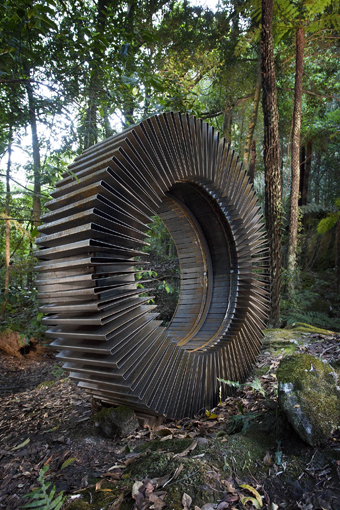
Al Phemister, Kern, Sculpture at Scenic World
photo Keith Maxwell
Al Phemister, Kern, Sculpture at Scenic World
Sculpture at Scenic World 2014
There’s still time to submit proposals for the annual Sculpture at Scenic World in the Blue Mountains which sees up to 40 works installed on the floor of the Jamieson Valley (see review of 2013 exhibition http://www.realtimearts.net/article/issue114/11099). The main acquisitive prize is $20,000 with a number of smaller awards. The 2014 exhibition (24 April-18 May) will also serve as the launch of a permanent sculpture commissioned from Ken Unsworth.
Applications due 14 Oct; http://www.scenicworld.com.au/experiences/sculpture/
Platform X: Transmedia Storyworld Writing, AWG
The Australian Writers’ Guild is seeking writers interested in interactive and multi-platform story telling to take part in Platform X: Transmedia Storyworld Writing. Eight writers from NSW and ACT will be selected for a three-day master class (30 Nov, 1 Dec, 7 Dec) run by Mike Jones, head of story development for Portal Entertainment UK and co-author of the multiplatform project Bloodline for publisher Simon & Schuster.
Applications due 17 Oct; http://awg.blacklight.com.au/images/pdfs/Platform%20X%20Entry%20Form%20and%20Guidelines.pdf
Still in the loop
raumlabor, Tin Sheds Gallery
Workshop 12-13 Oct (plus one day ATSC workshop induction if required 11 Oct); http://emergencity.net/special-workshop-with-raumlabour-berlin-book-now/
Nude models, Deborah Kelly, Sydney Biennale
Volunteers as portrait subjects, please send a picture of your face (only) to kellyproject@biennaleofsydney.com.au by Friday, 11 October 2013. For collage workshops, please send expressions of interest to frances@biennaleofsydney.com.au
Public Art major works, City of Sydney
Expressions of Interest due 31 October; http://www.cityartsydney.com.au/cityart/news/?p=1739
Revelation Film Festival 2014
Entries close 11 April 2014 http://www.revelationfilmfest.org/go/news/call-for-entries-now-open
Blacktown Arts Centre Residencies
Applications close 30 Sept
http://www.artscentre.blacktown.nsw.gov.au/performance/2014-performing-arts-residencies.cfm
Fisher’s Ghost Prize, Campbelltown Arts Centre
Entries due 4 Oct, 2013
http://www.campbelltown.nsw.gov.au/FishersGhostArtAward
House Proud 2014, Boroondara City Council
Applications close 30 Sept
http://www.boroondara.vic.gov.au/our-city/arts-culture/kewcourthouse/house-proud
version 1.0 masterclass
Masterclass 19 Oct, and bookings now open.
http://www.trybooking.com/Booking/BookingEventSummary.aspx?eid=60167
Melbourne White Night
Submissions close 1 Oct 2013
http://whitenightmelbourne.com.au/
Fast+Fresh Dance, FORM Dance
Registration closes 14 October
http://form.org.au/2013/01/fastfresh-dance-2/
FlickerFest call for entries
Deadline for Australian & International entries 11 Oct; for GreenFlicks & FlickerUp 18 Oct
http://www.flickerfest.com.au/
Next Generation Placement, ASSITEJ
Deadline for applicants 30 Sept
http://www.assitej-international.org/next-generation/
Forever Now
Applications open until June 2015
http://forevernow.me/
Selected Australia Council Grants
for full list see http://www.australiacouncil.gov.au/grants
Emerging and Experimental Arts – 4 October, 2013
http://www.australiacouncil.gov.au/grants/2013/experimental-arts-grants-4-october
RealTime issue #116 Aug-Sept 2013 pg. web
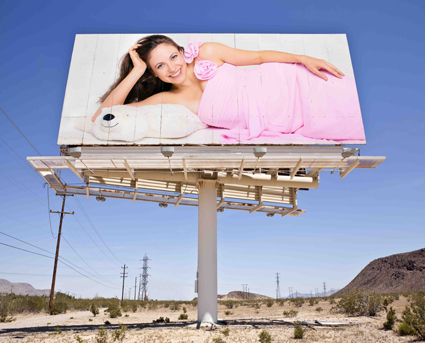
Nicola Gunn, In Spite of Myself
Melbourne Festival, quick picks from local works
The Melbourne Festival will kick off just before our next print edition hits the streets so here’s a run down of some of the local works. Particularly impressive are the number of festival co-commissions, nurturing Melbourne artists and the creation of exciting new performance experiences.
In Spite of Myself, Nicola Gunn, co-commission with Arts Centre Melbourne
Nicola Gunn and the Sans Hotel team have been in residence at the Arts Centre dreaming up an almost true life story for Gunn, presented as a faux retrospective of performance art titled Exercises in Hopelessness: Nicola Gunn (1979-present). Arts Centre Melbourne, Fairfax Studio; 9-13 October; http://www.artscentremelbourne.com.au/whats-on/event.aspx?id=3684
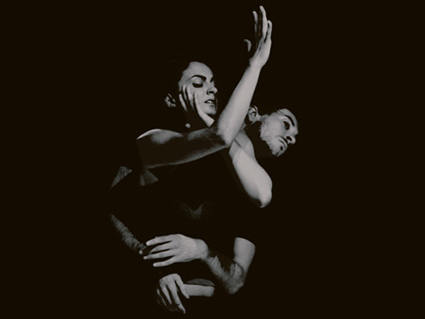
A Small Prometheus, Stephanie Lake & Robin Fox
photo Robin Fox
A Small Prometheus, Stephanie Lake & Robin Fox
A Small Prometheus, Stephanie Lake and Robin Fox, co-commission with Arts House
A dance work involving fire-driven kinetic sculptures and interactive sound. Arts House North Melbourne Town Hal 15-20 Oct; http://www.melbournefestival.com.au/program/genre/dance/a-small-prometheus.html
The Shadow King, co-commission with Malthouse
Michael Kantor and Tom E Lewis have co-created this Indigenous re-interpretation of King Lear melding “Shakespearian pathos with Aboriginal language, music and dance” (website). Malthouse, 11-27 Oct; http://www.melbournefestival.com.au/program/genre/theatre/the-shadow-king.html
M+M, co-commission with Theatre Works
Daniel Schlusser tackles Mikhail Bulgakov’s The Master and Margarita. Theatre Works, 8-16 Oct; http://www.melbournefestival.com.au/program/genre/theatre/mm.html
Room of Regret, co-commission with Theatre Works
The Rabble takes on Oscar Wilde’s The Picture of Dorian Gray filtering it through performance art, installation and audience interaction. Theatre Works, 21 Oct – Nov 3; http://www.melbournefestival.com.au/program/genre/theatre/room-of-regret.html
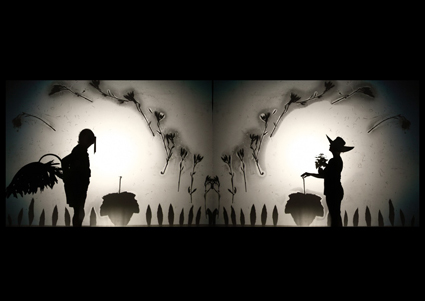
Sonic Flock, Click Clack Project
courtesy the company
Sonic Flock, Click Clack Project
Sonic Flock, Click Clack Project, presented by Footscray Community Arts Centre and the University of Melbourne
Enter a tee-pee and experience intimate music performed just for you. Over at Footscray Arts Centre there’ll also be performances by the Amplified Elephants, Rawcus and visiting Japanese sound artists. Atrium, Federation Square & Footscray Arts Centre, 12-13 Oct; http://www.melbournefestival.com.au/program/genre/music-classical/the-sonic-flock.html
The Black of the Star (Le Noir de L’Etoile), presented by Speak Percussion and SIAL Sound Studios
A percussion masterpiece by French composer Gérard Grisey featuring the pulses of neutron stars. (See review from Totally Huge 2011) Deakin Edge, Federation Square, 16-17 Oct; http://www.melbournefestival.com.au/program/genre/music-contemporary/the-black-of-the-star.html
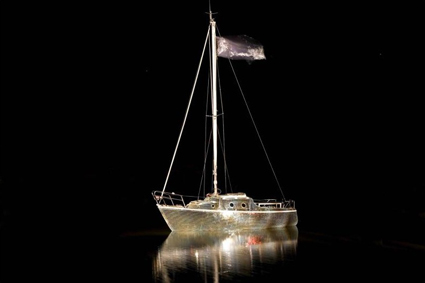
Celestial Radio 2012, Zoe Walker and Neil Bromwich, originally commissioned by Performance Space and the Museum of Contemporary Art Australia with the support of the Keir Foundation
photo Colin Gray
Celestial Radio 2012, Zoe Walker and Neil Bromwich, originally commissioned by Performance Space and the Museum of Contemporary Art Australia with the support of the Keir Foundation
Niteworks, Bundanon
This year’s Siteworks at Bundanon Trust’s Riversdale complex will be a Niteworks. The star of the evening will in fact be the stars with a presentation by scientists from the Anglo Australian Observatory. The Shoalhaven Astronomers club will also be bringing their telescopes for audience members to peer at the heavens. David Haines and Joyce Hinterding will create sounds via natural VLF transmissions and Nancy Mauro-Flude and Linda Dement will conduct a starlight séance of sorts calling up recently deceased rockers Ari Up (The Slits), Poly Styrene (X-Ray Specs) and Chrissie Amphlett (Divinyls). UK artists Zoe Walker and Neil Bromwich will sail their glittering vessel transmitting Celestial Radio sounds down the Shoalhaven and Diego Bonetto and Caterina Mocciola will take the audience on a moonwalk. There’s also the option of some rustic overnight camping.
The Bundanon Trust, Niteworks, Riversdale, 12 Oct; https://www.bundanon.com.au/siteworks
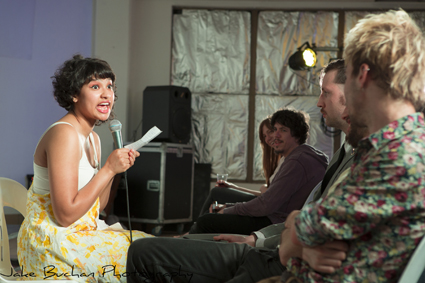
Nicole Henriksen. (For the 2013 festival Nicole will be performing a piece enticingly titled Naked Unicorn Vomit.)
courtesy Cracked Theatre Festival
Nicole Henriksen. (For the 2013 festival Nicole will be performing a piece enticingly titled Naked Unicorn Vomit.)
This Is Not Art, Newcastle
It’s the time of year to head north to Newcastle to experience the multi-headed beast that is This Is Not Art. This year the Crack Theatre Festival showcases a diverse selection of performances ranging across “circus, dance, cabaret, verbatim theatre, installation, multi media, comedy and live art” (press release). The National Young Writer’s Festival provides activities for budding scribes, including a writing workshop on the streets of Newcastle in the Paper Trail Tour, a Penguin Plays Rough presentation in the tunnels of Fort Scratchely, plus tips from celebrity chef Adam Liaw on cook book writing. The quiet achiever of TINA, the creative research symposium Critical Animals offers an impressive program of artists and thinkers including Tega Brain, Julian Day, Erica Secombe and Ben Kolaitis. There’s also the return of prodigal festival Electrofringe, presenting a day of showcases and the final festival party.
This Is Not Art, Newcastle, NSW 3-6 Oct; http://thisisnotart.org/
Festival of Toy Music, Brisbane Powerhouse
Curated by the tricksters of new music, Clocked Out, the Festival of Toy Music will feature performances by Margaret Leng Tan from the US (the queen of the toy piano we’re told), plus Australian musicians Matthew Horsley, Adam Simmonds, Clocked Out and of course there’s no show without the circuit-bent Barbies of Toy Death. There’s also a Dream Percussion installation sited in the Turbine Hall and available for everyone to unleash their inner percussionist.
Festival of Toy Music, 5 Oct, Brisbane Powerhouse; http://brisbanepowerhouse.org/events/2013/10/05/festival-of-toy-music/
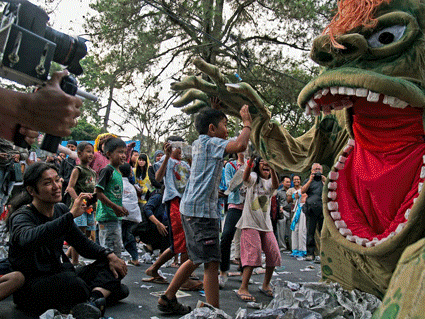
Wedhus Gembel, Snuff Puppets
Wedhus Gembel, Snuff Puppets
Wedhus Gembel is a long-time collaboration between the Snuff Puppets and a range of Indonesian artists. An outdoor performance, it’s “a parable about the cycle of life, the destructive power of nature and how innocence and beauty can be disguised in a monster” (website). Premiering in Yogyakarta and Jakarta in 2011, the wild mega-puppet antics of Wedhus Gembel will have its Australian debut at Federation Square featuring six guest artists from Indonesia.
Wedhus Gembel, Snuff Puppets, Federation Square Amphitheatre, 2-5 Oct; http://www.snuffpuppets.com/shows/Wedhus_Gembel

Not About Face, Luke George and collaborators
photo Jeff Busby
Not About Face, Luke George and collaborators
Not About Face, Luke George
In RT115 Rennie McDoougall gave us a sneak peak of Luke George’s work in development, Not About Face. “[T]he audience enters a rehearsal studio like cheap Halloween ghosts, donning bedsheets with eyeholes cut out…George, at first unidentifiable from the rest of us ‘ghosts,’ eventually emerges to claim his presence as shepherd to our flock. Once revealed he undergoes a series of transformations: channelling deceased performers, communing with a past version of himself through a television set and guiding us into summoning incantations of colour, to name a few.” George and collaborators are now ready to present the show to live a be-shrouded public at Dancehouse.
Luke George and Collaborators, Dancehouse, Melbourne, 9-13 Oct; http://www.dancehouse.com.au/performance/performancedetails.php?id=165
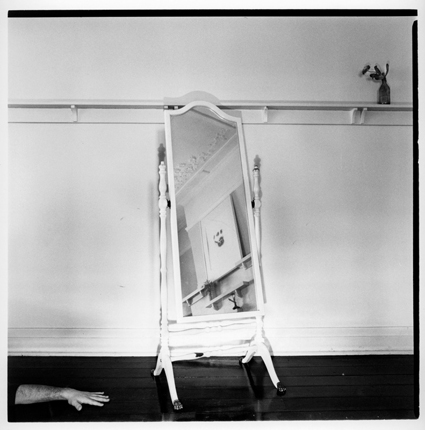
Aaron Bradbrook, Borderlands
© the artist
Aaron Bradbrook, Borderlands
Aaron Bradbrook, Perth Centre for Photography
Aaron Bradbrook is the 2012 winner of the Perth Centre for Photography’s UNCOVER Award which offers an emerging artist printing support, mentorship and a solo exhibition. Bradbrook’s exhibition Borderland focuses on the house as a site of endless playful possibilities, but also suggests a darker side as people appear only as segmented body parts. Bradbrook writes, “Like the subjects themselves, I want the viewer to feel they are being held captive in another world, a world in which they cannot leave” (press release).
Aaron Bradbrook, Borderland, Perth Centre for Photography,
26 Sept – 26 Oct, http://www.pcp.org.au
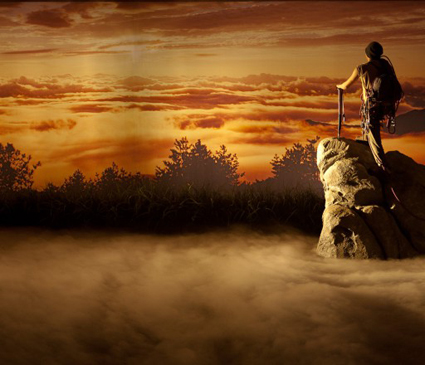
Yeondoo Jung, Documentary Nostalgia, video still, 2007
Yeondoo Jung, MAAP Space
The next exhibtion at MAAP Space in Brisbane presents South Korean artist Yeondoo Jung. Jung creates ambitious video works that explore memory truth and construction. The centerpiece of the exhibition is Documentary Nostalgia. shot in a single 84-minute take. Various scenes from the artist’s memory are literally constructed as theatre sets. More intimate in scale is Twilight Seoul created in collaboration with German artist Luka Fineisen. Using materials lying around in the studio the artists recreate by hand a scene of the hills around Seoul.
Yeondoo Jung, MAAP Space, 27 Sept-8 Nov; http://www.maap.org.au/projects/maap-space/yeondoo-jung/
in/Visible Women, Magdalena Australia
So if Tony Abbot is Minister for Women, it’s time to get a little forthright about women’s issues. Magdalena Australia, a coalition of female arts workers, is a long time advocate for women in the arts, but given the current political climate they are stepping up their activities. In particular they are responding to what they’ve identified as “an apparent lack of strong images of women in the printed program” of the current Brisbane Festival (press release). They will be presenting a Long Table discussion (a performative public talk format pioneered by Split Britches [US/UK]) around the visibility of women in performance. The discussion will be followed by a cabaret co-presented with Access Arts and Vulcana Women’s Circus.
Magdalena Australia Long Table, 27 Sept 5pm, cabaret 7pm; The Stores Studio, Brisbane Powerhouse; http://www.themagdalenaproject.org/en/content/invisible-women
Women’s issues continued… Live Art Development Agency
While we’re on the matter, the visibility of women in the arts is of course an international concern, one being addressed by a number of upcoming activities by London’s Live Art Development Agency. Through their Restock, Rethink, Reflect (RRR) series they’ll be presenting Just like a Woman, a program of talks and performances as part of the City of Women Festival in Ljubljana (Slovenia, 11-12 Oct). Back in London, Lois Weaver, inventor of the Long Table discussion format, will present a Long Table about Live Art and Feminism (16 Oct). Then the LADA partnership project Re.act, a performance archive of “feminist, gendercritical and queer performance art” (website) will return to Berlin, after a tour of Europe collecting even more material. Check out the website for workshops, performances, talks and other activities.
http://www.thisisliveart.co.uk/
Still in the loop
OzAsia, Adelaide Festival Centre
13-29 Sept
http://www.ozasiafestival.com.au/
Art and About, City of Sydney
20 Sept-20 Oct
http://www.artandabout.com.au/; http://metroscreen.org.au/whatson/
Gigi Scaria, Dust, Ian Potter Museum
18 September 2013 – 2 February 2014
http://www.art-museum.unimelb.edu.au/
Memory Collective, Toowoomba Art Gallery
Memory Collective, Toowoomba Art Gallery, 21 Sept-5 Nov; http://ww2.toowoombarc.qld.gov.au
User Generated Architecture, Tin Sheds Gallery
27 September-15 November
http://emergencity.net/user-generated-architecture/
Super Discount, Back to Back, STC, Malthouse
Sydney Theatre Company
20 Sept-19 Oct
http://www.sydneytheatre.com.au/what’s-on/productions/2013/super-discount.aspx
Nought, ADT, Samstag Museum
25 -27 Sept
http://adt.org.au/; http://w3.unisa.edu.au/samstagmuseum/
Kate Murphy, Probable Portraits
Shepparton Art Museum (SAM), 13 Sept-14 Nov
http://www.sheppartonartmuseum.com.au/
Open Frame, Room40
Brisbane Powerhouse and various venues
12-28 Sept
http://openframe.room40.org/2013
Craig Walsh, Embedded & Primavera, MCA
12 Sept-24 Nov
http://www.mca.com.au/
ikono On Air Festival
global, online
6-29 September
http://ikono.org/festival/
2013 Brisbane Festival
7-28 Sept
http://www.brisbanefestival.com.au/
arte magra: from the opaque, AEAF
5 Sept-5 Oct
http://www.aeaf.org.au/exhibitions/ArteMagra.html
The boat goes over the mountain, Happy Dagger Theatre
The Blue Room, Perth
10-28 Sept
http://blueroom.org.au/events/the-boat-goes-over-the-mountain/
Windows to the Sacred, S.H. Ervin Gallery
presented in association with Buratti Fine Art; 30 Aug-29 Sept
http://www.shervingallery.com.au/
Malthouse’s Helium
Little Ones Theatre, Salomé, 30 Aug-14 Sept
Smack! Bang, City of Shadows, Rachael Dease, 21 Sept-5 Oct
http://www.malthousetheatre.com.au/helium-2013/
In Confidence: Reorientations in Recent Art, PICA
31 Aug-13 Oct
http://www.pica.org.au
RealTime issue #116 Aug-Sept 2013 pg. web
© RealTime ; for permission to reproduce apply to realtime@realtimearts.net
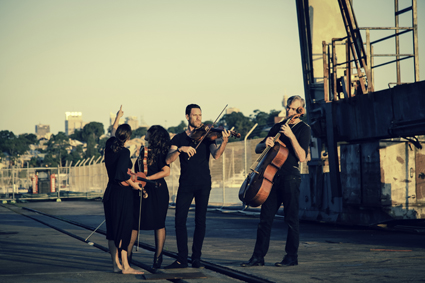
Mirabai Peart, Veronique Serret, James Eccles, Ollie Miller, The NOISE
photo Andrew Wholley
Mirabai Peart, Veronique Serret, James Eccles, Ollie Miller, The NOISE
After six years honing his viola playing skills in Berlin, James Eccles returned to Australia with an unusual ambition—to pursue a career in improvisational music-making in the contemporary classical music idiom and beyond. In the 18th and 19th century musicians and, not least, composers would be expected to publicly extemporize. In a return to tradition, Eccles is however not looking to the past so much as creating new musical possibilities for the future, realised in performances by The NOISE string quartet, which he leads, and its collaborators.
Ambition—and courage—are signalled by The NOISE’s latest venture, Composed NOISE: seven newly commissioned string quartets to be performed over two nights in Sydney’s Cellblock Theatre. These works by Australian composers— Andrew Ford, Rosalind Page, Paul Cutlan, Lyle Chan, Andrew Batt-Rawden, Alex Pozniak and Amanda Cole—“have been created through a collaborative process of workshopping and improvising, where the performers and composers function as equals. In this innovative process, performers become co-writers of the work, through their ability to improvise (or compose in real time)” (press release).
The NOISE
I met with Eccles to discuss Composed NOISE, but first asked about the musical background of the quartet’s players. The NOISE is made up of classically trained violinists Veronique Serret and Mirabai Peart, violist James Eccles and cellist Ollie Miller. Peart also has a busy career playing in the free-improvising Splinter Orchestra, jazz groups and the world music collective Tapestries of Sound. Miller, who plays classical and jazz piano as well as percussion is a member of the jazz group Amphibious. Having played with the Malaysian Philharmonic, the Tasmanian Symphony Orchestra and the ACO, Serret has also been a core member of Ensemble Offspring, was a founding member of the electronic/rock/classical band CODA and plays amplified violin for Inga Liljestrom’s band, elk. Eccles has played with Judy Bailey, DJ Spooky, Sydney Philharmonia Orchestra, Taikoz and Ensemble Offspring among others. With Miller he does an “avant garde rock thing,” performing recently at the VIVID festival in collaboration with electric guitarist Zane Banks. Soon Eccles and Miller will improvise over drones created by Julian Day as part of Day’s Infinity Room project.
The NOISE took shape, says Eccles, “after three of us were inspired by a Necks concert at the beginning of 2008. We found another violinist, started out as very much a little fun project and after several jam sessions said, let’s do a gig. There was a push factor from playing a lot of contemporary music and struggling with notes all the time, which can be great—it’s its own challenge. But we wanted to make our own music, to be creative and get a real kick out of it.”
Dealing wild cards
I ask Eccles about the kinds of improvisation involved in playing the seven quartets in Composed NOISE. He tells me that the degree of improvising varies considerably, from little to much, if in a variety of ways—sometimes where the composer has left space, or one or two players might improvise against the notated playing of the others, or when the composer might specify notes but not some other aspect of realization, like texture. However, for the quartet an important component of Composed NOISE has been the compositional-collaborative process. “I’ve had various meetings with the composers, starting last year. Lyle Chan based his piece on the blackjack card game. I liked the idea but then thought, hang on, we’re a quartet let’s have a real four-person game and immediately thought of bridge and 500.
“So we play a game of 500 before we perform the piece and that becomes the score. Lyall did a really good job finding a balance between what the cards stipulate and adding other instructions on top of that. There are 10 tricks in a hand of 500, so it’s a 10-movement piece and each trick has a specific instruction—glissando, pizzicato non-vibrato etcetera. Particular cards carry instructions: suits dictate register—hearts is the highest—and a number card will dictate certain rhythmic or grouping parameters. The face cards are complex and solo-istic, so the stronger the card, the stronger your part, while a number card will suggest a more accompanying role.”
As well as having to learn these rules, the players have to handle another quite lateral stipulation: “that the person who leads off the trick leads off the movement; but before they play they have to think of a type of weather, hence the work’s title, Smoke Weather Stone Weather. You don’t tell anyone what you’re thinking, they just react to what you’re playing. So that’s a real curve ball.
“For the purpose of the first performance we’ll video the game the day before, given all the logistics we have to get our heads around. But it won’t be rehearsed. It’ll still be spontaneous. Lyall’s piece is the most like what we do as The NOISE, reacting in the moment. We’ll probably do it many, many times.”
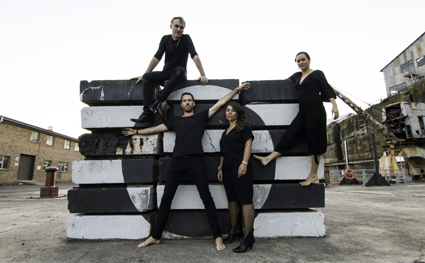
Ollie Miller, James Eccles, Veronique Serret, Mirabai Peart, The NOISE
photo Andrew Wholley
Ollie Miller, James Eccles, Veronique Serret, Mirabai Peart, The NOISE
Improvisation by degrees
Paul Cutlan’s contribution, Merge/Emerge, will also involve ample improvisation in a work “rooted in rhythm and harmony, in the tradition of Shostakovich and Britten, and with one delicious jazz moment when it comes.” The kinds of improvisation indicated in the score vary: “three of us will play the score with one player improvising, or there’ll be a bridging section with two people improvising and then we all come in and play a notated page and then one of us goes to a solo. Paul is a performer himself and really knew what we wanted to engage with and he knows the balance of how much to write and not write.”
Andrew Batt-Rawden has created “28” in which, says Eccles, the composer is “video-ed live writing the music—some of it pre-written over which he’ll overlay other elements as we play.” Alex Pozniak’s Force Fields, for amplified instruments, “ends with screaming feedback—a logical conclusion to a very intense piece. Some will love and some will hate it. It deserves to be picked up by other quartets. It’s more interpretive for us than improvisatory—Alex knows what he wants—but you have to determine how you might, say, make a stuttering effect on scratch tones.” Rosalind Page, Eccles tells me, “wrote her Master’s Thesis on Tarkvosky. Ollie’s also a big fan. I wasn’t convinced at first but now I’m a fan of The Mirror [1975], the film that’s inspired Rosalind’s piece, Zerkalo (Mirror). The film is autobiographical, about a father leaving his family, so each instrument plays a character—mother, child, father, poet—in musical dialogues. It’s hauntingly beautiful. Tarkovsky himself used soundscapes and music so strongly, referencing Bach. We’ll be improvising around some of the Pergolesi Stabat Mater.”
The other works in Composed NOISE are Amanda Cole’s Ecliptica and Andrew Ford’s String Quartet No 4, plus a bonus work by The NOISE themselves in the first concert of the two-night program. Ford’s composition was commissioned by Julian Burnside, while the other quartets were commissioned with funds from the Australia Council and those raised by The NOISE and Chronology Arts.
Ambition and freedom
Finally, I ask Eccles how ambitious he is for The NOISE. He laughs and says “Very!” But it’s no easy task given how busy the quartet members are. The goal is to work together one to two months a year, ideally on a major project like Composed NOISE but with an expanded palette that might include “a world music focus or an electric work or a studio album with overdubs.”
As for recordings, Composed NOISE will soon be available on CD and The NOISE has been recording Sydney-based composer George Lentz’s String Quartets—seven hours of it on NAXOS BluRay (apparently the only way to conveniently issue such a huge work). “It’s quite extraordinary playing beautiful chorale writing and improvising, providing source material for the mix—all tremolo, say, or all glissando. When we thought we were finished, George called to say he needed one more chorale section! It’s an installation work, but it might become a live performance,” says Eccles, apparently more excited than daunted by the work’s length.
I wonder if, after six years in Berlin, Eccles is happy working in Australia. He’s emphatically positive. “In Berlin it was mostly about learning to play the viola rather than being really creative—the good violist getting my viola chops up to work in an orchestras. I went to lots of Arditti Quartet concerts, but didn’t do much contemporary playing myself; it was mostly with orchestras doing Mozart and Beethoven. Here I’m a bit bigger fish in a smaller pond, I know the people, it’s my scene. I want to make things happen. It’s patriotic. I want to do things for Australian music. I’m inspired by nature and the sense of freedom here among my fellow collaborators.”
IMPORTANT NOTE: Due to a unforseen circumstances, the Composed NOISE concerts have had to be cancelled.
The CD Composed NOISE is now available on iTunes
For more information, www.thenoise.com.au; www.vexations840.com.
RealTime issue #116 Aug-Sept 2013 pg. web
© Keith Gallasch; for permission to reproduce apply to realtime@realtimearts.net
Interview with Cad Factory Artistic Director, Vic McEwan about A Night of Wonder, an evening of installation and performances onsite at the the Coleambally SunRice Mill in regional NSW.
Vic McEwan, Mayu Kanamori and visiting Japanese artist Shigeaki Iwai were in residence at the mill for three weeks developing responses to the site in consultation with mill workers and the local Coleambally community.
A Night of Wonder, 21 Sept, 2013
Video footage: Sam James
Editing: Gail Priest
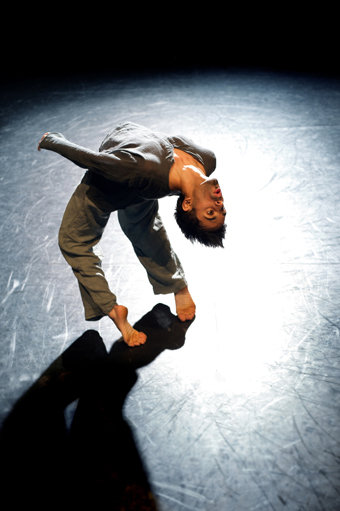
Aakash Rising
photo Chris Nash
Aakash Rising
One of Sydney’s most enjoyable festivals is Parramasala, a celebration of the South Asian culture of Western Sydney, featuring local performers and international visiting artists. Most striking, in the crowds at outdoor concerts, the marketplace, food stalls and indoor performances is evidence of cultural diversity that extends far beyond South Asia to eager audiences of South-East Asian, Chinese, Korean, Filipino, Pacific and Anglo and European heritage. There’s a palpable sense of curiosity and community.
Artistic director David Malacari (taking over from founding director Phillip Rolfe) tells me that he was attracted to Parramasala “because of the type of the festival it is. One of my hobbyhorses in New Zealand (Malacari was director of the Auckland Arts Festival, 2004-11) was for festivals to reflect the neighbourhood we’re in, and in Western Sydney it’s even more important. When you step onto the streets of Parramatta you encounter so many communities and cultures.”
Malacari feels that “what goes on on our stages should reflect this, and the audiences too, which are still largely of European background. It’s changing, with a few wonderful exceptions, but I’d like to see it change faster to reflect a new Australia. The festival introduces communities to each other, making the culture more than a sum of its parts—that attracted me to Parramasala.”
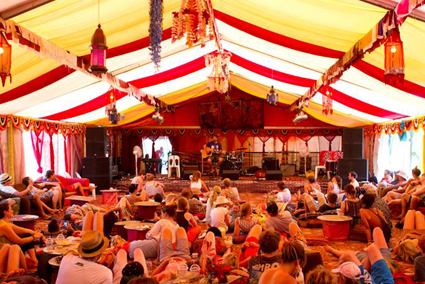
The Chai Temple
photo Kevin Bull
The Chai Temple
Completing the continuum
In the 2012 festival it was noticeable that ticketed shows were not, for the most part, well attended, while large, enthusiastic crowds gathered day and night for the free outdoor events. Doubtless many young families cannot afford tickets and some people may not be familiar with theatre-going. Malacari has wisely brought the outdoor and indoor events spatially closer together, locating the former in Prince Alfred Park right next door to the Riverside Theatres, instead of at the Town Square (a successful site but a distance from the theatres).
He sees this as providing a continuum on several fronts. There’ll be free events in the Riverside Theatres: in the sociable Chai Temple in the courtyard (chai, coffee, music from 5pm and a party on Saturday 5 October with famed musician Raghu Dixit), exhibited art and, in Rafferty’s Studio at 5pm over three days, free screenings of significant documentaries (see below). Malacari hopes these will tempt the curious into the theatre complex and perhaps even seduce them into a buying a ticket for a show.
A striking aspect of the 2012 outdoor program was the mix of professional, pro-am and community performances, ranging from traditional to contemporary, and hybrids in between, and largely of a high standard. Malacari sees this as important—the community performers and the professional virtuosi in the ticketed shows “being part of a continuum, with one being the bedrock of the other.” He also likes the idea of visiting professional artists walking out of the theatre into a rich community ambience,’ with the feeling of “a greater sense of a single festival.”
Fearless Nadia
Malacari saw Fearless Nadia, a 1940 Indian film accompanied by a large band of Australian and Indian players led by Ben Walsh, at the 2012 OzAsia in Adelaide: “It was fun—too good to pass up, a great centrepiece for the festival.” Featuring the incredibly popular Perth-born Mary Evans as its heroine who demolishes villains with slapstick ease, the film is an action-filled romp, replete with singing and dancing in the Bollywood tradition. Walsh and his musicians will be joined by visiting composer and virtuoso improviser Aneesh Pradhan, who will perform the tabla passages in Fearless Nadia.
Aakash Odedra
The many fans of choreographer and dancer Akram Khan will not want to miss seeing his protégé, Aakash Odedra. In Rising, this young, critically lauded star of British and South Indian dance will perform works created for him by Khan, Russell Maliphant and Sidi Larbi Cherkaoui alongside one of his own. Fusing the classical Indian dance disciplines of Kathak and Bharatanatyam with contemporary dance modes, Odedra is renowned for fast and intricate hand and footwork. With only two performance, Rising will be presented in the intimate Lennox Theatre.
Zameen
Another dance feature, this time with a political dimension, is the multimedia Australian-Indian creation Zameen, The Dam(n) Project. Malacari tells me he had been following the Attakkalari Centre for Movement Art, based in Banaglore, for a number of years only to serendipitously discover that they were already working with an Australian creative team: Jehan Kanga, composer Leah Barclay and Curious Works’ Artistic Director S Shakthidharan (whose The Other Journey was a Parramasala hit in 2011). After seeing an early version of Zameen at the Sunshine Coast’s Floating Land Festival, Malacari committed to presenting it at Parramasala. Reputedly a work of great beauty enhanced by the dancing of two members of the Attakkalari dance company, Zameen evokes the struggle of a remote community to preserve their land in the face of the building of a massive dam, a battle which it lost in large part, if managing to claw back some land. Malacari says, “the loss of land and water rights is germaine the world over, including in Australia.”
Manakottai In association with Information & Cultural Exchange (ICE), Malacari has programmed Sydney Nadaka Priyar, a local Tamil group, to perform Manakottai, a work they’ve devised in their own language but to be staged with English surtitles. “It’s a first for Parramasala,” says Malacari, “and could be a model for the future. I’m keen to use more language in the festival.” Katrina Douglas is director and dramaturg for the production—Malacari wants the work to be given the best opportunity to be professionally realised. The play focuses, with some humour, on the meaning of home, addressing “the expectations and experiences of two Tamil couples on intersecting journeys—one couple migrating to Australia and the other couple returning to India”—at Singapore’s Changi airport (website).
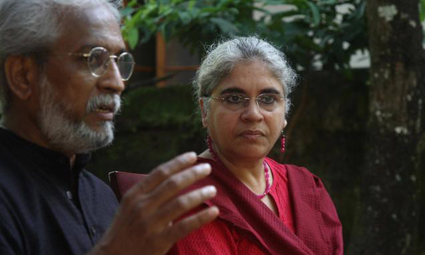
KP Jayasankar and Anjali Monteiro
Film: Anjali Monteiro and KP Jayasankar
The ICE Documentary Program (partnered with UWS and UTS) at Riverside, will screen three films over three nights at 5pm, each with a focus on significant social issues, ethnic tensions and declining cultural assets in India.
The prominent Indian documentary filmmaker pair Anjali Monteiro and KP Jayasankar, acclaimed around the world for their films about marginalised peoples, are guests of ICE and Parramasala, showing one of their best known films, Naata (2003), and a recent one, Like Here Like There (So Heddan So Hoddan; 2011). The latter “explores the worlds of three cousins, their families and the Fakirani Jat community to which they belong.” These people are devotees of Shah Abdul Latif Bhitai, a medieval Sufi poet, and inheritors of a rich tradition of poetry, song and instrumental playing that is fast dying out as the nomadism of these people is increasingly curtailed.
Naata (The Bond; 2003) is about Bhau Korde and Waqar Khan, “two activists and friends, who have been involved in conflict resolution, working with neighbourhood peace committees in Dharavi, Mumbai, reputedly, the largest ‘slum’ in Asia.” The two men use video, posters, audio-cassettes and above all a film they made, Ekta Sandesh, which they show with a portable screen and projector at their own expense. One writer says, “Their film is unabashed in its exploitation of Bollywood” and its use of celebrities and public officials arguing passionately for civic harmony. Anjali Monteiro and KP Jayasankar will participate in post-screening Q&As.
The third film in the ICE series also looks likely to be fascinating, Pritham K Chakravarthy’s Our Family (2007), a filmed solo performance about a family of three generations of trans-gendered female subjects and, says Malacari, “their tumultuous lives” in Tamilnadu.
Khovar Rewind and Semblance of Order
Another ICE contribution to Parramasala includes Khovar Rewind (at ICE, Parramatta, 30sept-31 Oct) an exhibition of mural works on paper, made in 1994 by tribal women artists from the Haziribagh region of Bihar in India “in response to the threat of physical and cultural displacement due to open cut coal mining. Created in the style of traditional Khovar (bridal) murals, each artwork is a delicate celebration of love, marriage and cultural unease” (website). The works, unseen for some 20 years, are from the Liverpool City Council Collection. Another indiosyncratic, paper-based exhibition Semblance of Order, presented with Parramatta Artist Studios, will show etchings and silkscreen prints by five artists from Pakistan and Australia.
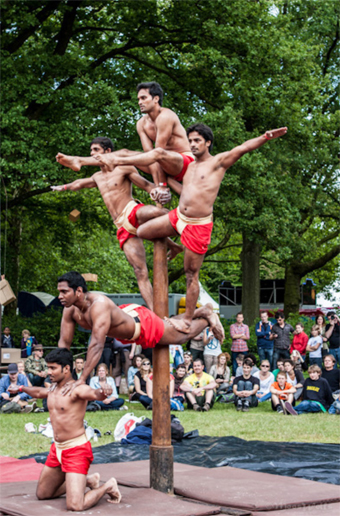
The Allakhamb Acrobats
courtesy Parramasala
The Allakhamb Acrobats
Mallakhamb Acrobats
When you’re in Prince Alfred Park look out for the Mallakhamb Acrobats from Mumbai with their astonishing gymnastics, balancing, for example, on their stomachs at the very top of the poles which are central to their work. As David Malacari says, this is something most people will never have seen.
My brief survey of the performances, films and exhibitions (let alone the music events you can read about on the festival’s website) suggests that much of Parramasala 2013 is likely to expand our sense of the nature of our relationship with Asia.
Parramasala 2013, 4-7 Oct; Khovar Rewind, ICE, 30 Sept-31 Oct; http://www.parramasala.com
RealTime issue #116 Aug-Sept 2013 pg. web
© Keith Gallasch; for permission to reproduce apply to realtime@realtimearts.net
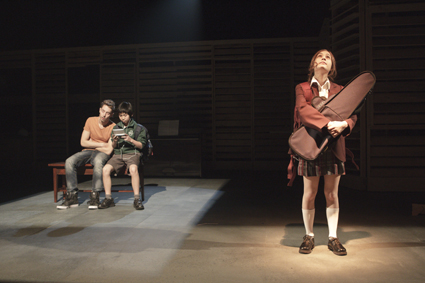
Matt Crook, Lawrence Mau, Danielle Catanzariti, Babyteeth, STCSA
photo Shane Reid
Matt Crook, Lawrence Mau, Danielle Catanzariti, Babyteeth, STCSA
A protracted gasp somewhere in the auditorium. An incredulous intake of breath? A snore? A derisory snort? No. Something darker. A shout, and the houselights go up, actors frozen on stage, suddenly displaced. The audience files out as green-jacketed paramedics file in. “She’s okay,” word comes down the line a little while later; a drop in blood pressure, she’ll go on, but some unexpected synchrony seems to have taken place, this irruption of the real underscoring playwright Rita Kalnejais’ overriding theme: the fragility of life in the face of omnipresent mortality.
Babyteeth charts, with filmic concentration, the last days in the life of Milla (Danielle Catanzariti), a fourteen-year-old with a terminal illness. The play is bookended by her death in the company of an unlikely bestie, gormless twenty-five-year-old druggie Moses (Matt Crook) whom Milla meets while waiting for her train after school. Fraught, fractured individuals surround them: Milla’s parents, Henry (Chris Pitman) and Anna (Claire Jones), her Latvian violin tutor Gidon (Paul Blackwell), her pregnant neighbour Toby (Alyssa Mason). The milieu, amplified by director Chris Drummond’s fussy, televisual instincts is again filmic, part Alan Ball, part David Lynch in its dark, coiled domesticity and depiction of suburban unease. Milla’s illness has pushed Anna towards seemingly irreversible neurosis, Henry, a psychologist, into smiling stereotypy and professional corruption. These are “etherised” lives, measured out, like Eliot’s J. Alfred Prufrock, “in coffee spoons.”
As Milla’s lifeforce wanes, her hair falling out—reducing the already slight Catanzariti to a glinting, gossamer ghost—it seems to take root elsewhere. Toby’s imminent baby is its physical manifestation. Gidon’s precocious Vietnamese student Thuong (Lawrence Mau or James Min on alternate nights) seems also to represent something that will be lost once Milla has gone. The moment when, provoked by her mother’s coaxing and the pain beginning to wrack her tiny body, she hurls her violin to the floor mid-practice, is one of the play’s most affecting. We share, then, for the first time, Milla’s knowledge that she will not live long enough to get as good as Thuong, that whatever promise she possesses—as a musician or, indeed, as anything else—will never be fulfilled.
Finally there is Moses, the object of Milla’s affection and prematurely burgeoning sexual ambition. There is, in their lovemaking, a further transmission of life. It is one of the final acts of Milla’s too short life and, like life, it is confused and unsatisfying. Moses may retain something, but what? A chemical memory? A point of access to a world normally refused him? Kalnejais does not provide a ready answer, nor position Milla as a redeeming angel. Their relationship—fumbling, clingy, unarticulated—remains shrouded in ambiguity even as its great charm overcomes our initial discomfort at the age gap and the sometimes brutal discrepancies in social status. As Moses, Matt Crook, in a contained and intelligent performance, lends the underwritten part of Moses depth and dignity, but it is Danielle Catanzariti who most impresses, finding endlessly variegated shades of emotional and physical nuance as both Milla’s body and innocence diminish.
Kalnejais asks that, at the play’s end, the stage revolves to reveal a negative image of the play’s opening scene. Milla’s incorporeal presence hovers on the outside looking in, peering through set designer Wendy Todd’s oversized wooden slats into the family home; her life, suddenly, without her in it. Light streams in from seemingly distant sources. Thuong plays something on the violin which swirls heavenwards like the first movement of Górecki’s Symphony No 3. Softly, dreamily, the stage is saturated with light and sound.
Milla’s tragedy, momentarily, defocuses the everyday, transcending the ordinary illusions and transgressions that we know will continue to master the lives of those she knew in life. It is these cracked, unresolved stories—of Milla’s mum and dad, of Moses, Gidon and Toby—which an elegiac death cannot reduce and which, in the end, may give the heart the greatest cause to ache—life as fragile, blundering onwards.
State Theatre Company of South Australia, Babyteeth, writer Rita Kalnejais, director Chris Drummond, designer Wendy Todd, lighting Geoff Cobham, composer Hilary Kleinig; Space Theatre, 16 Aug-7 Sept
See Keith Gallasch’s review of the premier production of Babyteeth at Belvoir
RealTime issue #116 Aug-Sept 2013 pg. web
© Ben Brooker; for permission to reproduce apply to realtime@realtimearts.net
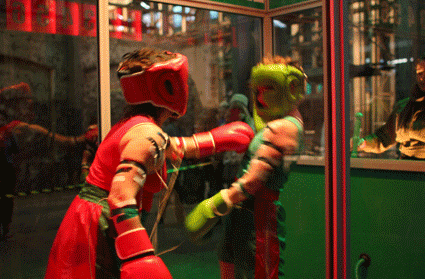
Game On, Michaela Davies
photos Claire Conroy & Geoff Ambler
Game On, Michaela Davies
Michaela Davies is not a woman to mess with. Not only is she well trained in boxing but she also has a PhD in Psychology. She has combined these skills in her latest work, Game On, which premiered at this year’s Underbelly Arts Festival.
Involuntary art & vicarious violence
Game On extends the work that Davies has been making with electric muscle stimulation (EMS), in particular her Compositions for Involuntary Strings. She composes works that are translated into midi data, then converted to EMS messages that are transmitted to the wired-up musicians who are literally shocked into playing the compositions, their involuntary muscle spasms providing wonderfully idiosyncratic extra musical sounds. (See RT113 and our ISEA blog).
For Game On, Davies uses a similar EMS technique, but ups the ante considerably. Inspired by a scene in Richard T Heffron’s film Future World (1973), she built a gaming booth in which live ‘boxers’ are controlled by audience members via oversized joysticks. The boxers’ muscles are stimulated into sequences that replicate the action of swinging, punching and blocking. The resulting match is curiously languid and hysterically wonky. Things hot up as the controlling masters of the game get increasingly more skilled and sometimes more aggressive.
GAME ON. Documentation from installation on Cockatoo Island for Underbelly Arts Festival. Sydney, Australia (2013), video by Boris Bagattini from Michaela Davies on Vimeo.
While the piece is evidently fun, it also poses questions about our pleasure in vicarious violence. The work also references the infamous Milgram experiment, in which people were given permission by a perceived authority figure to inflict lethal levels of electric current on unseen participants. In the Milgram experiment there were no actual victims (the participants’ cries were revealed to be pre-recorded), so Davies’ piece, in effect, takes this experiment a step further. Game On also removes the authority figure but replaces it with the performance context. Davies says: “the authority comes from the fact that it’s an artwork—they are doing it for art. But it’s still looking at where the responsibility lies. Maybe the players wouldn’t go up and shock someone on the street but because they’ve been given permission here, that makes it okay for them.”
Game On illustrates an interesting tension between Davies’ psychology and art practices: “There’s no way you could do something like Game On in a research environment, or as a psychological study because of ethics. Making art you have more freedom to explore ideas that you can’t explore in research because you simply wouldn’t be allowed. Or it would be so far removed from any kind of reality that it would be pointless. I’m wondering how long [this freedom] will last before artists will have to submit ethics applications to make an artwork that involves the public.” [This is already an issue for art practice as research within universities; see Kate McNeill and Barbara Bolt, “The ‘legitimate’ limits of artistic practice,” RealTime 104, Eds]
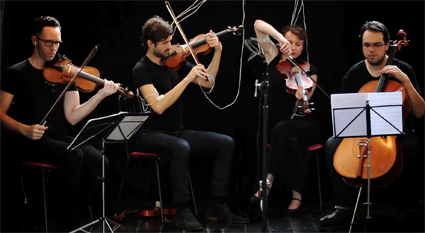
“Untitled for Cyborg String Quartet” (voluntary & involuntary players), Michaela Davies in collaboration with Kyle Sanna
Obstructionism
Game on and the Involuntary Strings project are of course about more than sadism: they reflect Davies’ overarching interest in agency and free will. Her next project involves a series of videos in which musicians play a piece which they know very well but have to battle an obstruction—for example a guitarist wears mittens while trying to play “Stairway to Heaven.” Davies says, “I am interested in the way obstruction can change performance, or change behaviour—how people cope with different obstruction. I’m also looking at this from an historical experimental music perspective—chance operations… Those artists were trying to remove people from what they’re making, to give them more freedom—through obstruction—to create something new.”
A work Davies is developing for her appearance at the Sonica Festival in Glasgow will involve a pianist performing a classic piece (yet to be decided) which Davies, in a duet of sorts, will interrupt with EMS impulses. She says, “She’ll be fighting against the involuntary EMS to try and play. I’m really interested in that struggle.” With this and the video pieces Davies is “interested how performance becomes a recital. It’s easy for musicians to not really think about what they’re playing any more. I’m looking at ways of changing that.” In the early Involuntary Strings pieces it seems musicians voluntarily relinquish control. In these later works Davies allows the musicians a semblance of control and then actively interferes with it.
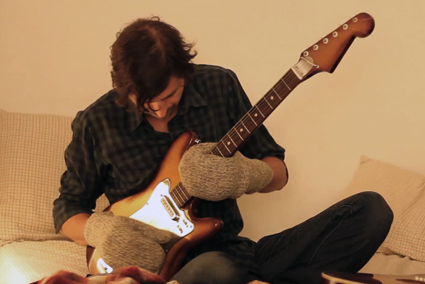
Kyle Sanna plays Stairway to Heaven, Michaela Davies
courtesy the artists
Kyle Sanna plays Stairway to Heaven, Michaela Davies
This development reflects Davies’ thinking as a psychologist: “People develop disorders and problems because of conflicts between themselves and society and what society expects. I don’t think they actually need free will or more will power to get better. It’s more about looking at the contexts these things develop in, rather than having more control over yourself. I don’t think anyone ultimately has much control over anything. We’re just rats pressing a bar for food.” I look forward to that experiment manifesting as an artwork.
COMING UP: Sonica: Compositions for Involuntary Strings, Tramway, Glasgow, 2 November; http://sonic-a.co.uk/compositions-for-involuntary-strings/; Game On, Damien Minton Ballery, opening 12 November; http://www.michaeladavies.net/
RealTime issue #116 Aug-Sept 2013 pg. web
© Gail Priest; for permission to reproduce apply to realtime@realtimearts.net
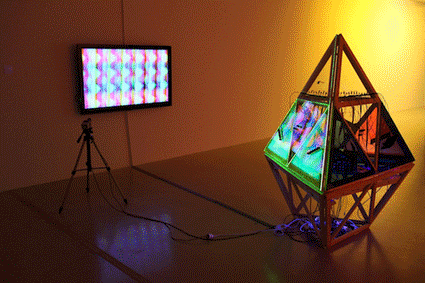
Tetra Synth, 2013, Pia van Gelder & Stephen Jones
courtesy the artists
Tetra Synth, 2013, Pia van Gelder & Stephen Jones
Pia van Gelder is the “Overlord”of the Sydney chapter of Dorkbot, a loose international network of “people doing strange things with electricity.” She is also incredibly active as a curator (co-director of the Moduluxx festival and the now-ended Serial Space), an educator and artist.
Van Gelder’s practice involves performance and installation works utilising what she describes as “media machines” which she hacks and reconfigures. She says “hacking or tinkering is a way to look for a new aesthetic…to explore or reveal the machine’s intrinsic visual or audio language, sometimes arriving at surprising results. But mostly I’m looking at how a machine can have its own form of expression [either through an] electronic aesthetic or the machine’s connection to the outside world and the people around it.” In her artist statement van Gelder talks of the pursuit of an “AV mysticism.”
Heirloom machines
Van Gelder is particularly interested in older technologies, which she refers to as heirloom machines. “This is a term Joyce Hinterding and I came up with when I was doing my masters. There are machines, like the video synthesiser for instance, that are historic and rare…a prize possession.” There’s an interestingly female flavour to the term—a small reclamation of machines from an assumed male custodianship.
Van Gelder has recently collaborated with Stephen Jones to recreate one of these machines. Based on Jones’ original 1996 designs for a video synthesiser, they have recreated the Tetrasynth. It’s a pyramidal object with one colour from the video spectrum—red/green/blue—assigned to each side. It allows users to play, manipulating the colours via generators and filters to create abstract video images. The work was commissioned by Campbelltown Art Centre for their exhibition Catching Light, part of ISEA 2013 (see realtimeTV and review).
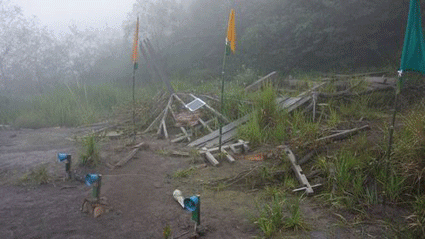
Mountain Operated Synthesiser (MOS), 2013, Mt Mehrapi, Pia van Gelder, Michael Candy, Andreas Siagian
courtesy the artists
Mountain Operated Synthesiser (MOS), 2013, Mt Mehrapi, Pia van Gelder, Michael Candy, Andreas Siagian
Collaboration
While the term ‘geek’ offers the impression of lonely souls working in isolation, only communicating virtually, the contemporary use of the term ‘hacker’ infers a shift beyond software to actual object modification and is strongly associated with the idea of real-world communities. Hacker spaces are popping up all around the world where people come to share tinkering tips, tools and resources. Before this year, Van Gelder had not participated in many collaborative art processes (curating aside), but now she’s making up for this.
As well as the Tetrasynth project, she has also recently taken part in the Instrument Builders Project in which Australian and Indonesian artists came together at iCAN in Yogyakarta (see review). Van Gelder teamed up with Brisbane-based artist Michael Candy and Indonesian artist Andreas Siagian to create the Mountain Operated Synthesiser. Inspired by a solar-powered seismic monitoring station half way up Mt Mehrapi, an active volcano 28 kilometres north of Yogyakarta, the trio have created an instrument that is played by the mountain. It comprises three flags dug into the ground, each holding three oscillators. The flags have analogue senses sewn on or built into them, capturing wind and moisture levels and soil activity. This data then activates the oscillators creating a raucous sonification of the mountain’s conditions. It doesn’t sound very pretty but it’s a wonderfully integrated concept.
Gender issues
Hacking is an area of practice notoriously dominated by males and I asked Van Gelder how this affects her practice. “The Instrument Builders Project was a very good example—there were no other female practitioners on that bill of artists. (There was, of course, Kristi [Monfries] who was one of the curators.) And it came up in discussion from time to time. You have to recognise that imbalance and talk about it, but you also can’t let it get to you, even though it can feel quite isolating…If we don’t recognise that it’s a male dominated field then it becomes even more unappealing [for women]. But if you make a point of making space, making women feel recognised and comfortable, that’s a way of moving past it, just a little bit.”
What’s next
Van Gelder has already achieved a lot this year, but there’s still more to come. She’s one of five artists who have been commissioned to make works for the Tele-Visions festival celebrating the passing of analogue TV (part of Performance Space’s 30th birthday celebrations). For Tele-Visions Van Gelder will perform a series of experiments for live television broadcast involving participation from the audience in the studio. “It’s kind of like a cross between a global groove and a science show.” If only the Curiosity Show was still around today—Pia van Gelder would make the perfect host(ess)!
COMING UP: Pia van Gelder (represented by First Draft) will exhibiting at the inaugural Sydney Contemporary, Carriageworks, Sydney; 20-22 September 2013 ; http://piavangelder.com/
RealTime issue #116 Aug-Sept 2013 pg. web
© Gail Priest; for permission to reproduce apply to realtime@realtimearts.net
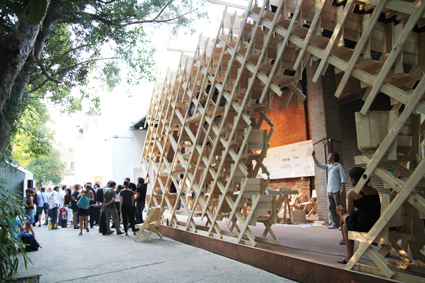
Generator workshop, raumlabor berlin
raumlabor, Tin Sheds Gallery
To complement the exhibition User Generated Architecture (see quick picks), Christof Mayer and Andreas Krauth, artists from the collective raumlabor berlin will be conducting a two-day workshop in “instant, participatory building practices in public space” (press release). The workshop is free but places are limited.
Workshop 12-13 Oct (plus one day ATSC workshop induction if required 11 Oct); http://emergencity.net/special-workshop-with-raumlabour-berlin-book-now/
Nude models, Deborah Kelly, Sydney Biennale
Artist Deborah Kelly is calling for subjects to pose for a number of life-sized nude portraits. These will then be integrated into collages in a series of public workshops starting in October with the final works exhibited during the 19th Biennale of Sydney.
Volunteers as portrait subjects, please send a picture of your face (only) to kellyproject@biennaleofsydney.com.au by Friday, 11 October 2013. For collage workshops, please send expressions of interest to frances@biennaleofsydney.com.au
Public Art major works, City of Sydney
Sydney’s CBD will be changing dramatically over the next few years with traffic rerouted, pedestrian zones created and a light rail system installed. Expressions of interests from artists are now invited for major public artworks to be sited on what is being called the George Street Spine and the smaller East-West cross streets.
Expressions of Interest due 31 October; http://www.cityartsydney.com.au/cityart/news/?p=1739
Revelation Film Festival 2014
The dates are set for next year’s Revelation Film Festival 3-13 July (see Keith Gallasch’s report on this year’s event), and submissions are now open. Categories include narrative features, documentary, short film, animation and experimental projects. There’s a pretty long lead-time so you could start something now and still be ready for the deadline.
Entries close 11 April 2014 http://www.revelationfilmfest.org/go/news/call-for-entries-now-open
Still in the loop
Blacktown Arts Centre Residencies
Applications close 30 Sept
http://www.artscentre.blacktown.nsw.gov.au/performance/2014-performing-arts-residencies.cfm
Fisher’s Ghost Prize, Campbelltown Arts Centre
Entries due 4 Oct, 2013
http://www.campbelltown.nsw.gov.au/FishersGhostArtAward
House Proud 2014, Boroondara City Council
Applications close 30 Sept
http://www.boroondara.vic.gov.au/our-city/arts-culture/kewcourthouse/house-proud
version 1.0 masterclass
Masterclass 19 Oct, and bookings now open.
http://www.trybooking.com/Booking/BookingEventSummary.aspx?eid=60167
Melbourne White Night
Submissions close 1 Oct 2013
http://whitenightmelbourne.com.au/
Fast+Fresh Dance, FORM Dance
Registration closes 14 October
http://form.org.au/2013/01/fastfresh-dance-2/
FlickerFest call for entries
Deadline for Australian & International entries 11 Oct; for GreenFlicks & FlickerUp 18 Oct
http://www.flickerfest.com.au/
Workshops & Residencies, Lucy Guerin Inc
Applications for studio residencies & workshop places due 23 Sept
http://www.lucyguerininc.com/studio-projects/Studio_Residency; http://www.lucyguerininc.com/studio-projects/Hotbed
Next Generation Placement, ASSITEJ
Deadline for applicants 30 Sept
http://www.assitej-international.org/next-generation/
Forever Now
Applications open until June 2015
http://forevernow.me/
Selected Australia Council Grants
for full list see http://www.australiacouncil.gov.au/grants
Music: Fellowships – 17 September 2013
http://www.australiacouncil.gov.au/grants/2013/music-fellowships
Music: Project Fellowships – 17 September 2013
http://www.australiacouncil.gov.au/grants/2013/music-project-fellowships
Music: Don Banks Music Award – 17 September 2013
http://www.australiacouncil.gov.au/grants/2013/don-banks-music-award
Music: Skills and Arts Development – Artist Development – 17 September 2013
http://www.australiacouncil.gov.au/grants/2013/music-skills-and-arts-development-artist-development-17-september
ArtStart – 23 September 2013
http://www.australiacouncil.gov.au/grants/2013/artstart2
Emerging and Experimental Arts – 4 October, 2013
http://www.australiacouncil.gov.au/grants/2013/experimental-arts-grants-4-october
RealTime issue #116 Aug-Sept 2013 pg. web
© RealTime ; for permission to reproduce apply to realtime@realtimearts.net
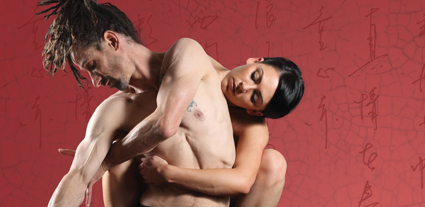
Leigh Warren Dance, Not According to Plan
OzAsia, Adelaide Festival Centre
The annual OzAsia festival is already in full swing, but there are plenty of festivities still to come. Leigh Warren Dance presents the premier of Not According to Plan, following the journey of dancer, photographer, choreographer and calligrapher Xiao Xiong Zhang “from a life of unimaginable isolation into one of a worldwide dance family” (website). There’s a mini-focus on Malaysia with Parah by Instant Café Theatre looking at the hidden political rifts in Malaysian society, and SuperEverything*, a live cinema collaboration between UK video outfit The Light Surgeons and Malaysian artists Ng Chor Guan, Hands Percussion and Rhythm in Bronze. Touching down in Adelaide on a national tour is Fight the Landlord, a collaboration between Ireland’s Pan Pan Theatre and Beijing’s Square Moon Culture performed in the round by ladies in panda suits (see review RT111). There’s also the quiet charmer Stories Then and Now directed by Annette Shun Wah and William Yang (see RT115). This weekend join the Moon Lantern festivities, and of course you wouldn’t want to miss Kamahl in concert!
Adelaide Festival Centre: OzAsia Festival, 13-29 Sept; http://www.ozasiafestival.com.au/
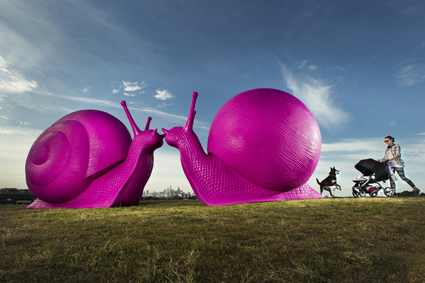
Snailovation, Cracking Art Group
Art and About, City of Sydney
Art and About is hitting Sydney with a plethora of public art adventures. Watch out for giant pink snails made entirely from recyclable materials by UK artists Cracking Art Group; or see yourself multiplied in the 324 mirrors that will populate Hyde Park in Field by New Zealand team Out of the Dark. You can take on a virtual persona and immerse yourself in the micro-world of a model railway in I Think I Can by Sam Routledge, Martyn Coutts and Performance Space. Or you can experience the thrills of Spill, a high energy dance work in several public parks around the city created by Shaun Parker. A special commission by Carbon Arts, Keith Deverell’s Building Run manifests the energy consumption data of five CBD buildings represented by five avatars running for their future. Extending the festivities to East Sydney, Metro Screen will be running a Pop-up Cinema and Bar at the Paddington Town Hall, including a whole night of shorts from a RealTime favourite, Lena “Girls” Dunham.
Art & About, various venues Sydney, 20 Sept-20 Oct; http://www.artandabout.com.au/; http://metroscreen.org.au/whatson/
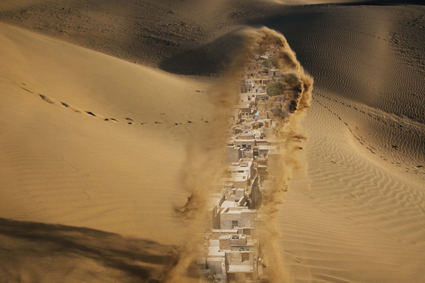
Gigi Scaria, Dust
Gigi Scaria, Dust, Ian Potter Museum
Gigi Scaria was one of the artists to appear in the first ever Indian Pavillion at the Venice Biennale in 2011. Over the last two years he’s spent time in Australia on a cultural exchange courtesy of the Macgeorge Fellowship, University of Melbourne. Dust is his first major solo exhibition here and draws on what he sees as a “strong connection between the Australian and Indian continents” (press release). Through video, large-scale photography and painting Scaria explores the salt plains of the Kutch area, presenting quite a different vision of India from those we normally see.
Gigi Scaria, Dust, Ian Potter Museum, 18 September 2013 – 2 February 2014; http://www.art-museum.unimelb.edu.au/
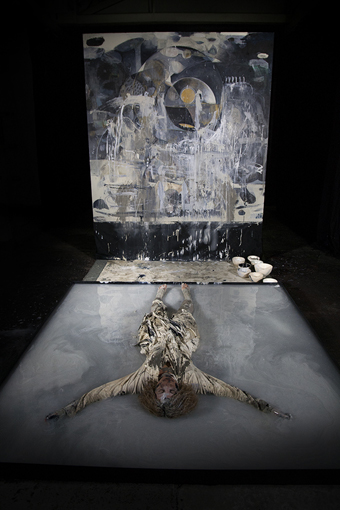
Memory Collective
photo Victoria Cooper+Doug Spowart
Memory Collective
Memory Collective, Toowoomba Art Gallery
Soon to be exhibited at the Toowoomba Art Gallery in south-east Queensland are the results of a large scale collaborative artmaking project by the Memory Collective. Painter and project initiator Damien Kamholtz first created a large format painting. He then invited 12 local artists from a range of disciplines including dance, ceramics, sculpture, textile design, music, photography and filmmaking to respond to the work over various stages. This interaction has both transformed the original painting and created a number of related artworks. (See clip for performance documentation).
Memory Collective, Toowoomba Art Gallery, 21 Sept-5 Nov; http://ww2.toowoombarc.qld.gov.au
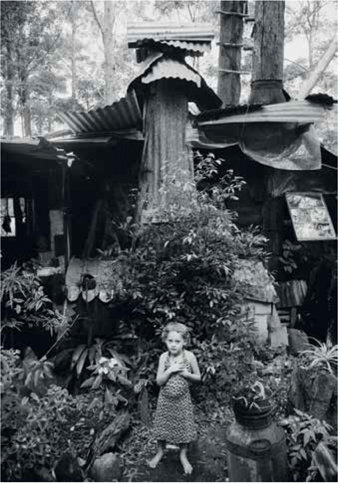
Tim Hixson, Main Arm Mullumbimby (detail), mid 1970s
User Generated Architecture, Tin Sheds Gallery
As part of the Sydney Architecture Festival, Tin Sheds Gallery will be presenting two exhibitions under the umbrella title User Generated Architecture. Not Quite Square, a joint venture with Lismore Regional Gallery, surveys the alternative owner-builder culture that developed in the Northern Rivers region in the 1970s. The partner exhibition features the architecture collective raumlabor berlin. Working at the intersection of urban planning, architecture and intervention the collective creates large-scale installations in public space exploring architecture as an “experimental laboratory” and a “participatory practice” (press release). They will also be conducting a two-day workshop (see opportunities).
Tin Sheds Gallery, Faculty of Architecture Design and Planning, University of Sydney; 27 September-15 November; http://emergencity.net/user-generated-architecture/
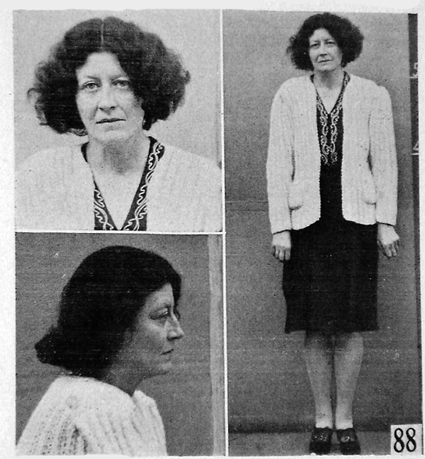
Underworld Songs, Astra
Martin Friedel’s Underworld Songs, Astra
The choral chamber society Astra’s next concert presents a new work by composer Martin Friedel, Underworld Songs. Friedel has been a Creative fellow at the State Library of Victoria where he has been rummaging through tabloid and police reports from the 1950s. He’s created a six-scene suite for choir, soloists, small instrumental ensemble and projected image that looks at “ordinary lives that have gone wrong” (press release). Performed across two atmospheric venues at the Abbotsford Convent, Underworld Songs is complemented by choral pieces by Mendelssohn and Riccardo Vaglini.
Astra Chamber Music Society, Martin Friedel’s Underworld Songs,
Abbotsford Convent, 21-22 Sept 3pm; http://www.astramusic.org.au/
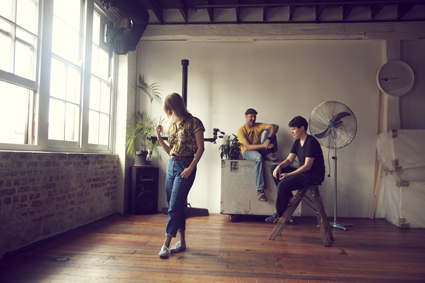
Whips & Tendrils, Triangulate
Whips and Tendril, Campbelltown Arts Centre
The next New Music Network Mini-Series concert is at Campbelltown Arts Centre and focuses on native bird sounds. Whips and Tendrils will be in 9.1 surround sound and features compositions by Triangulate—Sarah-Leith Izzard, Karin Senff and Andrew Bluff. The concert is also part of the Sydney Sacred Music Festival. (View a previous piece by this interesting trio here.)
Triangulate, Whips and Tendrils, Campbelltown Arts Centre; 21 Sept; http://www.campbelltown.nsw.gov.au/WhipsandTendrils; http://sydneysacredmusicfestival.org/events/
Still in the loop
Super Discount, Back to Back, STC, Malthouse
Sydney Theatre Company
20 Sept-19 Oct
http://www.sydneytheatre.com.au/what’s-on/productions/2013/super-discount.aspx
Flock, Weave Movement Theatre
Mechanic Institute Performing Arts Centre, Brunswick
19-22 Sept
http://www.melbournefringe.com.au/fringe-festival/show/flock/
Nought, ADT, Samstag Museum
25 -27 Sept
http://adt.org.au/; http://w3.unisa.edu.au/samstagmuseum/
Kate Murphy, Probable Portraits
Shepparton Art Museum (SAM), 13 Sept-14 Nov
http://www.sheppartonartmuseum.com.au/
Open Frame, Room40
Brisbane Powerhouse and various venues
12-28 Sept
http://openframe.room40.org/2013
Craig Walsh, Embedded & Primavera, MCA
12 Sept-24 Nov
http://www.mca.com.au/
Drawn to Experience: Performance Drawing
POP Gallery (Postgraduates and Other Projects) , Queensland College of Art, Griffith University
12-21 Sept
http://www.kellieo.com/?page_id=1213
ikono On Air Festival
global, online
6-29 September
http://ikono.org/festival/
2013 Brisbane Festival
7-28 Sept
http://www.brisbanefestival.com.au/
arte magra: from the opaque, AEAF
5 Sept-5 Oct
http://www.aeaf.org.au/exhibitions/ArteMagra.html
The boat goes over the mountain, Happy Dagger Theatre
The Blue Room, Perth
10-28 Sept
http://blueroom.org.au/events/the-boat-goes-over-the-mountain/
Windows to the Sacred, S.H. Ervin Gallery
presented in association with Buratti Fine Art; 30 Aug-29 Sept
http://www.shervingallery.com.au/
Malthouse’s Helium
Little Ones Theatre, Salomé, 30 Aug-14 Sept
Smack! Bang, City of Shadows, Rachael Dease, 21 Sept-5 Oct
http://www.malthousetheatre.com.au/helium-2013/
In Confidence: Reorientations in Recent Art, PICA
31 Aug-13 Oct
http://www.pica.org.au
RealTime issue #116 Aug-Sept 2013 pg. web
© RealTime ; for permission to reproduce apply to realtime@realtimearts.net
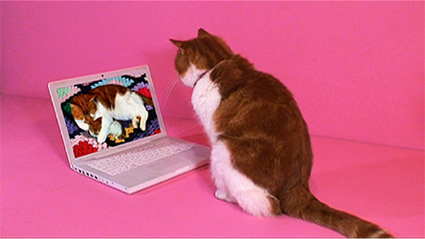
Jessica McElhinney, CatTube, 2011
At the turn of the millennium video festivals and screening programs were reaching plague proportions, but now that screens themselves have become infestations and we live on a drip-feed diet of YouTube, the festivities have been floundering for want of a cohesive context. This is a challenge Channels, the newest video festival on the block, is tackling head on.
Channels has been initiated by an all-lady curatorial team of Jessie Scott, Rachel Feery and Eugenia Lim. The women met while participating in the Next Wave Kickstart program and over the years have, independently and collaboratively, curated a range of video and time-based media events. I asked Lim what compelled them to launch a new video festival. She suggested that perhaps there is currently “a loss of criticality about the medium. It seems like the history of video gets lost and re-invented with each generation. I think we felt that now was a good time to try and connect to that past but also to look at the directions video is going in. It seems to be in constant mutation. [The impetus] was a combination of our own experiences of programming and curating up to this point, trying to look critically at the practice, and also [a desire] to promote video to a wider audience, making it accessible but with a certain rigour to it. [We want] artists working in this way to feel like they’re part of a larger community and audiences to get a look at some of the finest work that we feel is being made at the moment.”
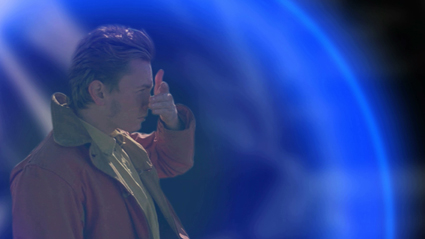
Soda_Jerk, The Phoenix Portal, 2005
Channels is attempting to present video as a medium in a range of manifestations. At the core of the event are the single-channel screenings drawn from an international open call that attracted 900 entries. These have been narrowed down to 33 works split across two thematic screening sessions; Sensory Drive + Media Mash-ups and Constructed Worlds + Bodies Collide (see ticket giveaway at the end of this article).
In an attempt to reach a wider audience, the main screenings will be in the ACMI Cinemas. There’s also a program specifically curated for Federation Square’s big screen, Channel Surf, which has been carefully programmed to suit the less concentrated viewing context. Lim says, “Channel Surf is a nod to that transient experience of passing through. The works that we are showing there are almost visual billboard works that you can come in and out of […] There are some really great artists being shown—Jessica McElhinney has made a really great work called CatTube. It’s a wonderful, concise look at internet and video culture…For us it was a great opportunity to try and screen something in such a high foot-traffic, general public kind of space. It’s a way of broadening the reach and the awareness of what else we’re doing.”
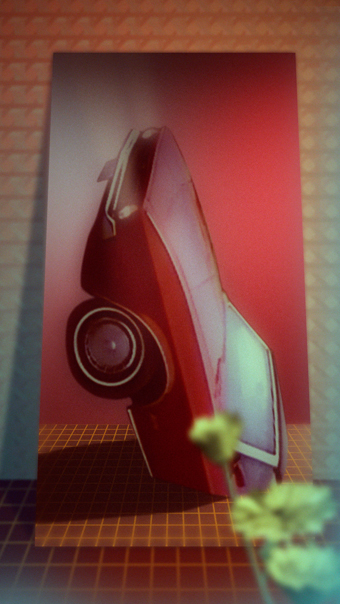
Ms&Mr, Videodromes for the Alone series: Amputee of the Neurotic Future 1988:2012
The other cornerstone of the festival is Transformer, an exhibition at ScreenSpace comprising two commissioned video installations. Ms&Mr will continue their Videodromes for the Alone series with Amputee of the Neurotic Future 1988:2012 which incorporates footage from the artists’ own videographic past into a JG Ballard-Cronenbergian contemporary reality. This will be exhibited as a three-channel work with an automotive sculptural component. Both complementing and contrasting with this will be Benjamin Ducroz’s Cumulo, filmed in the Pilbara, combining stop motion animation of cloud formations and a kinetic sculpture which appears on screen and as an object in the space.
Exploring the relationship between video and performance art is Mirror Screens, co-curated with Laura Castagnini. This comprises three specially commissioned performances by Emile Zile, Hannah Raisin and Salote Tawale where each artist has made a new performance/video piece (ie performance on, for or with video) inspired by a work from the historical avant-garde canon. For example Zile, appearing via Skype, will conduct a wake, using a roll call of names generated from Russian spam and scam sites that references Ant Farm’s 1975 performance Media Burn.
But don’t turn the dial yet—there’s more. Co-presented with the Victorian College of the Arts, US performance and video artist Barbara Rosenthal is a special guest delivering her lecture “Old Masters of New Media,” an overview of her prolific career from 1963 to 2013. There’s also a forum, Video Art In The Internet Era featuring Vernon Ah Kee, Ian Haig and Norie Neumark with video postcards from Skip Blumberg, Joel Stern and Soda_Jerk. Channels has also teamed up with the ikono On Air Festival, an international event which sees artfilms broadcast across the world on satellite channels and via internet streaming (see last week’s In the Loop).
No video festival is complete without some outdoor projections, in this case a program called Nocturnes screening on Chin Chin’s Wall of Art on the corner of Higson and Flinders Lanes. And of course there’s a party to finish off the event in style. Channels has teamed up with Speakeasy Cinema (run by Ghita Loebenstein) to present Videodromes, including VJ performances, smoke installations and a beanbag cinema. So if you’re in Melbourne, get off the couch and go surfing.
Channels Video Festival, curators Jessie Scott, Rachel Feery, Eugenia Lim, program associate Ghita Loebenstein, Memory Screens co-curator Laura Castagnini, ACMI and various venues, Melbourne, 18-21 Sept; Transformer exhibition, ScreenSpace, 12-21 Sept; http://www.channelsfestival.net.au/
GIVEAWAY: Channels festival is offering one double pass to the Video Visions sessions 1 & 2; email onlinegiveaways@realtimearts.net with Channels in the subject line (by Sept COB Sept 12).
Barbara Rosenthal will also be appearing in Brisbane at Metro Arts (Oct 4), Audiopollen (Oct 6), Room60 Talks (Oct 9) and IMA (Oct 10).
RealTime issue #116 Aug-Sept 2013 pg. web
© Gail Priest; for permission to reproduce apply to realtime@realtimearts.net
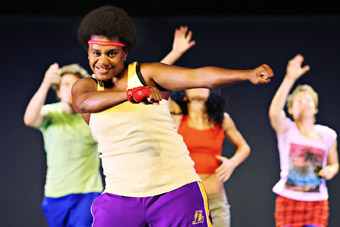
Ghenoa Gela, Happy as Larry, Shaun Parker & Company
photo Prudence Upton
Ghenoa Gela, Happy as Larry, Shaun Parker & Company
At the end of a long and tiring day, this was a work that instantly gathered me up, gave me a quick hug and held my hand from start to finish. I was drawn in right from the start, literally. A giant blackboard formed the dominant stage set and the dancer I came to think of as Larry (Timothy Ohl) stood alone on stage as the audience entered, drawing rows of people he identified as “You,” then adding one childlike image of a person labelled “Me.” From here on Larry manipulated the performance with the drawings and words flowing from his chunky coloured chalk.
Director Shaun Parker has chosen to pose the question “What Makes Us Happy?” by depicting his dancers as different personality types. Each character’s choreography reveals their personality, what makes them happy, and how that happiness transforms when they interact with each other. The Boss derives happiness from marking the space in which another can dance. Beginning as a fun game for both, the restricted dancer becomes frustrated as the size of the marked space decreases. The Observer, always watching from the sidelines, enjoys happiness vicariously but is never able to engage fully in the joy of those he observes. The Perfectionist gains happiness from his own body and fails to fulfill the needs of the Tragic Romantic as she tries in vain to secure his devotion. The Performer initially bathes in the admiration of his audience until his failed act loses their support.
The large blackboard is cleverly manipulated about the stage, acting as a signboard to the changing vignettes exploring friendship, love, loneliness and, of course, happiness. Added to this are some simple props—balloons, a pair of rollerskates, a striped basketball—complemented by subtle lighting which enhances the simplicity of the design.
The soundtrack, drawing from a range of musical styles, reflects the changing moods of the piece and the mix of dance styles, from contemporary, to street, to roller disco. As time and again happiness fades, the music too returns from its upbeat percussive and bass drive to sorrowful, classical string tones. This dynamic suggests a theme of happiness lost, giving the score dramatic cohesion.
One final, high energy scene with the entire cast lifts the spirits in a happy, chalky, sweaty mess before the dancers slowly depart the stage, leaving Larry alone as the solo violin saws out its lament.
Through most of the performance I laughed, I smiled, I felt energised by the sheer joy and physicality of the choreography. Even when things turned sour I remained optimistic that happiness would return. Then I stepped out of the theatre and ever since I’ve had a creeping sense of sorrow that recognises the fragile and transient nature of happiness. As Parker notes, human happiness “is precious…as elusive as it is concrete” (program note).
It was wonderful to see Josh Mu return to the Darwin stage. As a boy, Josh performed with Tracks Dance Company. With no tertiary dance or drama education available in the Northern Territory, many of our talented young performers pack up their swags and head south to pursue their careers. Josh is now clearly at the peak of his physical abilities. I felt a happiness that the director could never have intended. Seeing an artist master his craft, I swelled with a bit of local pride.
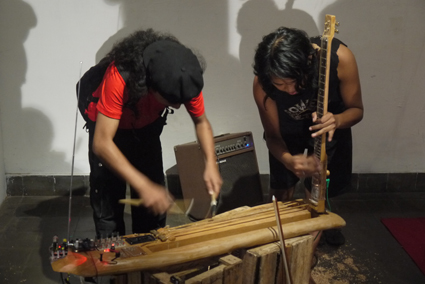
Lintang Radittya, Ikbal S. Lubys performing with Wukir Suryadi’s Akar Mahoni (Mahogany Root)
photo Joel Stern
Lintang Radittya, Ikbal S. Lubys performing with Wukir Suryadi’s Akar Mahoni (Mahogany Root)
Recently the Australian International Cultural Council (AICC) announced funding for a number of Australian/Indonesian cultural projects and the first of these was The Instrument Builders Project. I wanted to check it out not only because it sounded like fun, but as an Australian artist living in Indonesia, I’m very interested in the broader issues surrounding the Australian Government’s re-definition of ‘cultural diplomacy’ in light of the recent Australia in the Asian Century White Paper.
Within days of the instrument builders arriving I’d heard rumours about the artists who had hiked up Mt Merapi (the active volcano about 40km from the city centre) and installed devices that produced sounds from shifts in the atmospheric conditions near the crater. The installation was devised by Andreas Siagian, one of the founders of Lifepatch, a Yogya geek/art collective, in collaboration with Pia Van Gelder from Dorkbot and Serial Space in Sydney and Michael Candy, a young media artist from Brisbane. (For more on this project read next week’s In Profile feature on Pia van Gelder.)
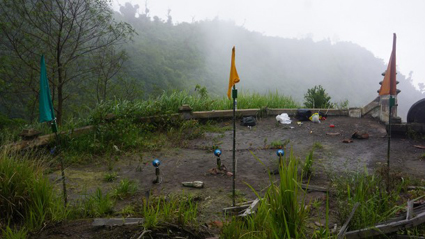
Michael Candy, Pia Van Gelder, Andreas Siagian
MOS (Mountain Operated Synthesizer), 2013
The rest of The Instrument Builders Project took place at iCan (Indonesian Contemporary Art Network), a space for open ended, research driven, multidisciplinary projects in Yogyakarta. Given the short time that the Australian artists had in the country (three weeks), they got straight to work constructing and modifying instruments, discussing their various approaches, playing together and preparing to exhibit their work.
I’m a big fan of Wukir Suryardi’s work, in particular his band Senyawa which combines rigorous research into traditional music, experimental approaches and a disciplined theatricality. Other participants came from very different backgrounds and I was curious to know how this combination would resolve itself. Dylan Martorell for example, makes percussive instruments from found objects with a loose DIY aesthetic, Rod Cooper is a sculptor and Ardi Gunawan is fast developing a profile in both Australia and Indonesia as a visual artist interested in process driven projects.
I attended the three public presentations in the final week of the project, each of which had moments of brilliance, where the dialogue between all of the participants was resonant and compelling, and at other times descended into noisy chaos. One of the sweetest moments came after a particularly loud section, when ethnomusicologist Asep Nata played a minimal, unamplified interlude with a jaw harp and a steel bell. For an excruciating moment it seemed something had gone horribly wrong, until one by one the other musicians returned to the performance.
To the curators’ credit the performances were not so structured that they eliminated risk or the possibility of failure, or tried to pander to the audience’s expectations. Instead they presented the instruments in different contexts over the three public showings. The first was a group improvisation with a choreographed dance work. The second showcased each instrument, followed by a loosely structured composition (arranged by Gatot D Sulistiyanto and Tony Maryaan from the Yogya group Art Music Today). For the final showing the instruments were presented as an installation that could be played by the audience. Without sacrificing its experimental nature, the project was framed in a way that gave the audience a number of entry points and just enough information to see where they were going. Yogya can be fabulously DIY but sometimes a little lazy when it comes to presentation and The Instrument Builders Project certainly raised the bar in terms of professionalism.
I talked to a number of the participants about their experiences and their thoughts about cross-cultural exchanges. Dylan Martorell pointed out that this project happened within a continuum of projects between experimental sound artists in Australia, Indonesia and elsewhere. Several of the Indonesian artists had performed in Australia and some of the Australians (including Martorell) had previously worked in Indonesia. “It’s not like we suddenly turned up in a remote village wanting to collaborate with traditional musicians. Basically everyone involved here is interested in the same kinds of music, so in that sense we already shared a common language.”
Kristi Monfries, one of the project co-curators, was a little more circumspect. “Working in a cross-cultural environment, like it or not, there’s often misunderstanding, mainly through language or a misreading of cultural conditions. In many ways our job as the curators of this highly collaborative project was to not only select artists on their artistic merit but also on their openness to adventure and experimentation.”
Co-curator Joel Stern added, “There are differences, but mostly practical ones. In Indonesia the cost of living is cheap and so is the cost to build or buy stuff and work on a scale that is unaffordable for most artists in Australia. On the other hand, in Australia you can access funding for experimental projects a lot more easily than in Indonesia.”
Indonesian artists don’t have the luxury of government grants to fund their projects and often rely on money from foreign governments to fund non-commercial or experimental projects. It’s significant to note that Japan, the US, France, Germany, Holland and other countries generously fund Indonesian artists and organisations. Until recently, Australia has been conspicuously reticent, only willing to fund projects that promote Australian product abroad.
AICC’s recent shift to funding collaborative projects is welcome, although still falls short of what other countries contribute. Given the rapid social change currently happening in this region and the accompanying explosion of cultural debates and artistic production, it seems a lost opportunity for Australia to not participate more proactively.
Collaborative projects, when they work, can be transformative for everyone involved, opening up ongoing dialogues and exchanges and sometimes producing unexpectedly great results. While ‘cultural difference’ is an overused and often misunderstood term, practical differences in each country undeniably influence the way a work is produced and received—well conceived collaborations such as The Instrument Builders Project are able to harness the best of both worlds.
The Instrument Builders Project, curators Joel Stern & Kristi Monfries, artists Rod Cooper, Dylan Martorell, Pia Van Gelder, Michael Candy, Wukir Suryadi, Asep Nata, Ardi Gunawan, Andreas Siagian, iCan (Indonesian Contemporary Art Network), Yogyakarta, Indonesia; 24 June-16 July, 2013; http://theinstrumentbuildersproject.com/
RealTime issue #116 Aug-Sept 2013 pg. web
© Malcolm Smith; for permission to reproduce apply to realtime@realtimearts.net
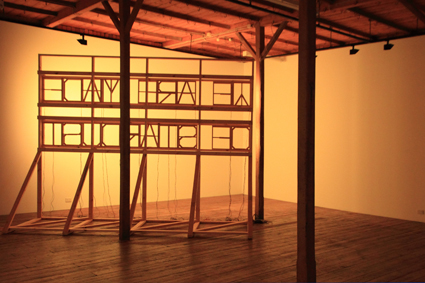
Michaela Gleave, We Are Made of Stardust, 2013
courtesy of the artist and Anna Pappas Gallery
Michaela Gleave, We Are Made of Stardust, 2013
The expression “We are made of stardust” both positions humankind within a vast, magnificent universe and reduces us, notionally, to the ashes of which everything consists. It’s the central message—at face value, at least—of Michaela Gleave’s Universal Truths, an exploration of the search for meaning inspired by a research residency with the CSIRO’s Astronomy and Space Science Division.
At Anna Pappas Gallery in Melbourne, Universal Truths comprised five works ranging from the quietly mesmerising We Are Made of Stardust—a large billboard-like installation emanating coloured LED light along with its message—to smaller LED pieces and a series of Lambda prints on photographic rag paper. The works responded in different but interrelated ways to the artist’s time at facilities including the Australia Telescope Compact Array at Narrabri and the Bureau of Meteorology solar observatory on the same site.
Asked about the ideas the residency prompted, Gleave first describes her fascination with the language she encountered—hearing how astronomers use the word ‘sky’ for example, “which I’d thought might be a very old-fashioned way of approaching the universe,” and discovering first-hand how the terminology used exposes the historical evolution of science.
“The residency made me acutely aware of how fleeting ideas about reality can be, especially in astronomy, where the field is leaping ahead in such vast steps […] I also thought a lot about the knowledge that is left behind by so-called advances: there is a process of forgetting that comes about through the de-valuing of older knowledge systems, and we potentially lose valuable ‘truths’ as a result.”
Ultimately, says Gleave, the science of cosmology is “just about trying to find meaning in our own lives. It becomes about how we see ourselves in relation to our surroundings.”
We Are Made of Stardust dominated the small upstairs room at Anna Pappas. On a utilitarian wooden frame were arrayed hundreds of LEDs, spelling out the work’s eponymous message and linked to an RGB controller, wiring exposed and dangling. The coloured light morphed through the rainbow—pink to red to vermilion to gold to lemon to lime to emerald and beyond—a visually lush reference to advertising, constellations, starfields. Crucially, the entire structure was positioned to face the meeting of two walls, rendering the message obscure until the viewer walked into its blind corner. From ‘inside’ the corner the words shone bright, searing into the retina; while ‘outside’ the impression was of nebulous but ever-present influence.
The glowing LEDs are, says Gleave, an extension of previous experiments with light as a tactile medium; suggesting romance and whimsy, as well as advertising’s false promises.
“With We Are Made of Stardust I [also] wanted to capture the extreme senses of scale that are often behind my atmospheric installations, using text as a means of conveying large ideas whilst maintaining a very personal and tactile response to the physicality of the object and the present-ness of the individual’s experience. Billboards are vehicles for fiction, often used to stand in for much larger physical presences.”
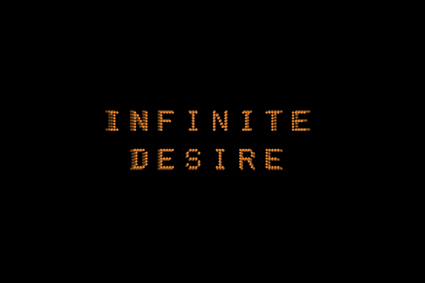
Michaela Gleave, Infinite Desire, 2013
courtesy of the artist and Anna Pappas Gallery
Michaela Gleave, Infinite Desire, 2013
A pair of small works, Universal Truth and Infinite Desire, echoed We Are Made of Stardust with their aspirational sentiment; each was a small wall-mounted sign, again made of LEDs, referencing, in Gleave’s words, “tacky signs hanging in convenience store windows or cheap beauty salons, hyper-luminous…” In their deep box frames, between panes of dark glass, the LEDs, mounted at the front surface, reflected their monochromatic dots of light off the back panel to create a receding procession of images; truth and desire fading into a false third dimension. The signs drew attention humbly, while around them on the white walls the shifting colours of the larger work provided a constant reminder of that eternally morphic stardust.
“The text in [both Universal Truth and Infinite Desire] recedes into the infinite darkness,” says Gleave, “[they are] bittersweet pronouncements commenting on the contradictions of our human desire for understanding. There are no universal truths when even the speed of light, thought to be a universal constant, has been seen to change. And despite science telling us that there is no meaning to life, science’s very existence is due to the persistent human desire to find meaning.”
Model for the end of the universe (1–4) and Untitled (Teufelsberg, 2010) scaled the viewer’s experience down further, towards its limits. The former, a series of four Lambda prints, presented sets of small symbols on deep black backgrounds—curving arrowheads, or little dots like abstracted entities. Each print refers to a potential entropic ‘end-point’ proposed by current scientific thinking, says Gleave; they are based around dance notation and created as “an event-based score.” The latter work was a photograph—a close-up of concrete tarmac covered in fragments of broken glass. The image, so pedestrian, seemed to zoom back out to infinite scale, asking ‘where are we in all this?’
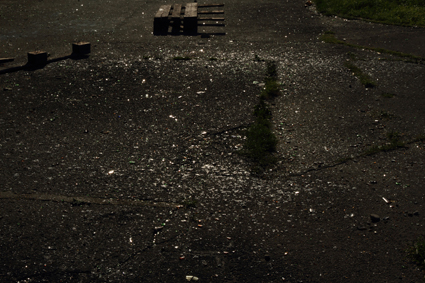
Michaela Gleave, Untitled (Teufelsberg 2010), 2010
courtesy of the artist and Anna Pappas Gallery
Michaela Gleave, Untitled (Teufelsberg 2010), 2010
Gleave points to the inevitable interpretations of images that, as humans, we’re driven to make: “The broken glass appears as a field of stars, blues and reds refracted from the white light, with cracks in the concrete and strips of grass standing in for the dark of gas clouds. […] To me this image is a partner piece for the billboard. We are made of stardust, yet ultimately we’re grounded and our immediate present is all we really have.”
Though dominated by its quasi-billboard, Universal Truths was an understated show, requiring—and rewarding—contemplation. Somewhat coolly, Michaela Gleave presented a field of observation, referencing the stars but subtly illuminating points of reference closer to home: our billboards and petty concerns, blinking lights and everyday desires. Far from suggesting that we are insignificant, the work somehow raised pavement debris, consumer-driven desire, human finitude and the mysteries of the universe to the same level. The ‘gallery space’ perhaps mirrored ‘outer space’—distant and inscrutable at first, but opening up to investigation. Not quite able to place ourselves, visitors were there, nevertheless, bathed in light—observers implicated (and somehow validated) in the process of observing.
Michaela Gleave, Universal Truths, Anna Pappas Gallery, Prahran, Melbourne, 2 July-3 August, 2013; http://annapappasgallery.com/
See also Darren Jorgensen’s review of A day is longer than a year at PICA
This article first appeared as part of RT’s online e-dition 11 Sept, 2013
RealTime issue #117 Oct-Nov 2013 pg. 45
© Urszula Dawkins; for permission to reproduce apply to realtime@realtimearts.net
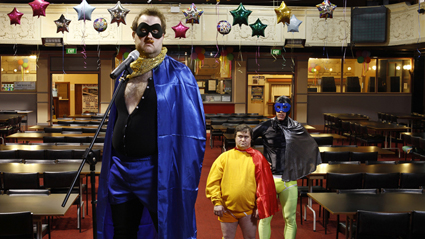
Super Discount, Back to Back Theatre
photo Jeff Busby
Super Discount, Back to Back Theatre
Super Discount, Back to Back, STC
Back to Back has continued to impress with a performance vision that is utterly unique, endlessly inventive and thoroughly brave (see RT’s Arts and Disability archive highlight for a collection of Back to Back articles). The Geelong-based company will be premiering their new show, Super Discount, as part of the 2013 Sydney Theatre Company season, continuing at Malthouse later in the year. Directed by Bruce Gladwin, devised by company members and featuring choreography by Antony Hamilton, Super Discount interrogates the archetypal comic book action hero, fighting against all odds. “Sticky notions of identity, representation and power are pulled apart and investigated with humour and candour” (press release).
Back to Back, STC, Malthouse: Super Discount, Sydney Theatre Company; 20 Sept-19 Oct; http://www.sydneytheatre.com.au/what’s-on/productions/2013/super-discount.aspx
SUPER DISCOUNT DISCOUNT: STC is offering RealTime readers $30 tickets for previews Sept 20, 21, 23, 24. Use this link to book with the code REALTIME.
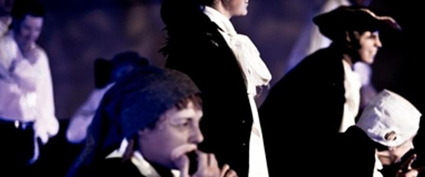
Flock, Weave Movement Theatre
photo Pippa Dodd
Flock, Weave Movement Theatre
Flock, Weave Movement Theatre
Another “ability inclusive” company, Weave Movement Theatre will be presenting their new work, Flock, as part of the Melbourne Fringe Festival. Directed by Janice Florence, a paraplegic dance artist, Flock looks at “social connectedness, human interactions and social exchanges” via movement, dance and theatre. (See Philipa Rothfield on Weave’s Capsule; and an article by Janice Florence on the Art of Difference)
Flock, Weave Movement Theatre, Mechanic Institute Performing Arts Centre, Brunswick, 19-22 Sept; http://www.melbournefringe.com.au/fringe-festival/show/flock/
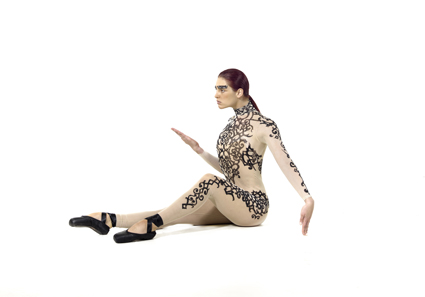
Nought, Australian Dance Theatre
photo credit Chris Herzfeld – Camlight Productions
Nought, Australian Dance Theatre
Nought, ADT, Samstag Museum
Australian Dance Theatre will be premiering a new work choreographed by Daniel Jaber at the Samstag Museum. Jaber has danced with ADT since 2004 and Nought represents a number of firsts for both him and the company: it’s Jaber’s first full length work; the first show to be commissioned by ADT from a company dancer; and the first ADT show be presented in a gallery setting. Jaber says “Nought is an experiential performance where the audience is taken through a process of discovery, ending with a poignant insight into the dancing body and the dancer’s fragility” (press release).
ADT: Nought, choreographer Daniel Jaber, Anne and Gordon Samstag Art Museum, 25 -27 Sept; http://adt.org.au/; http://w3.unisa.edu.au/samstagmuseum/
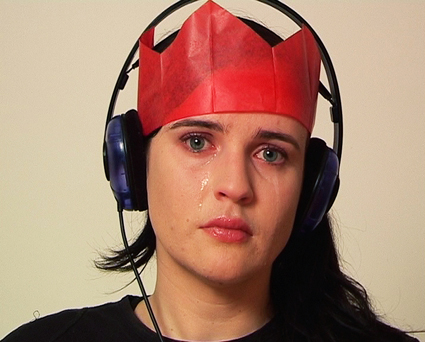
Kate Murphy Cry me a future (Dublin), 2006
courtesy of the artist and BREENSPACE, Sydney © the artist
Kate Murphy Cry me a future (Dublin), 2006
Kate Murphy, Probable Portraits, SAM
Shepparton Art Museum is presenting their largest screen-based exhibition to date with this survey of the video practice of Kate Murphy. The exhibition will feature key pieces exploring themes of family, ritual and aspiration including Prayers of a Mother (1999, see RT57 http://www.realtimearts.net/article/issue57/7262), the Britney Love series (2000/2007), Assembly (2009) and Yia Yia’s Song (2010, see RT100 http://www.realtimearts.net/article/issue100/10128). Murphy also turns the camera on herself in Cry me a river (Dublin) (2007) which depicts the artist’s tearful response to a clairvoyant’s reading.
Kate Murphy, Probable Portraits, Shepparton Art Museum (SAM), 13 Sept-14 Nov; http://www.sheppartonartmuseum.com.au/
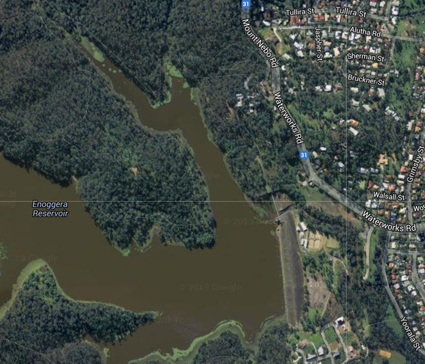
Sound walk with Anthony Magen & WestHead Projects, Open Frame
Open Frame, Room40
There have already been a few activities staged for Room40’s annual festival, this year themed The Future is Noise. David Toop, David Grainge (author of the recently released book Noise Matters, Bloomsbury 2013) and Amelia Barrakin have already duked it out in a forum at IMA. Plus the amazing Japanese sound artist Akio Suzuki has performed in Brisbane and at Lismore Regional Gallery. The festival will culminate in a concert series at Brisbane Powerhouse featuring Francisco López (Spain), Mark McGuire (US), Laurel Halo (US), Objekt (Germany) and local artists. There’ll also be a soundwalk led by Anthony Magen through the Brisbane State Forest Park featuring the West Head Project crew, Monica Brooks, Jim Denley and Dale Gorfinkel.
Room40: Open Frame, Brisbane Powerhouse and various venues; 12-28 Sept; http://openframe.room40.org/2013
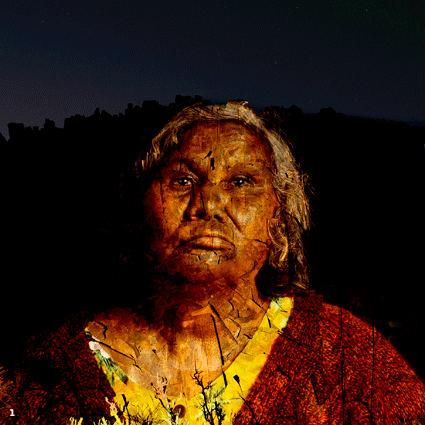
Craig Walsh, In Country (2012); 1) Pansy Hicks, courtesy the artist and Pansy Hicks; 2) Tim Douglas, courtesy the artist and Tim Douglas; 3) Tootsie Daniels, courtesy the artist and Tootsie Daniels; © the artist
Embedded & Primavera, MCA
Embedded is a follow-up to Craig Walsh’s 18-month regional tour, Digital Odyssey (2010-11). For this project Walsh resided for four weeks in and around the Burrup Peninsula in north-west Western Australia, courtesy of the MCA and Rio Tinto. He worked with the community, Indigenous elders and the mining company exploring differing attitudes to the environment: “’land’ as commodity and ‘Land’ as spiritual and cultural guidance” (Walsh, press release). The exhibition comprises a wide-screen video work, Standing stone site (2012) and a multi-channel piece, In Country (2012), in which community elders are literally embedded in the rock-scape as they discuss spiritual aspects of the land.
Spring is also Primavera time at the MCA with this year’s exhibition for artists under 35 curated by Robert Cook (Art Gallery of Western Australia). His vision includes painting, sculpture, video and sound works by Jacqueline Ball (WA), Jackson Eaton (WA/VIC), Heath Franco (NSW), Brendan Huntley (VIC), Thomas Jeppe (WA/VIC), Jess Johnson (VIC), Juz Kitson (NSW) and Kusum Normoyle (NSW).
Craig Walsh, Embedded & Primavera, MCA, 12 Sept-24 Nov; http://www.mca.com.au/exhibition/craig-walsh/
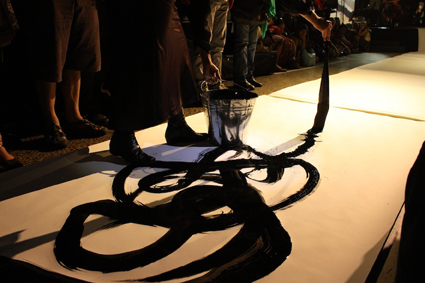
Kellie O’Dempsey, MONA FOMA, 2012
photo Goegina Tait, courtesy the artists
Kellie O’Dempsey, MONA FOMA, 2012
Drawn to Experience, POP Gallery, QLD College of Art
Drawn to Experience is a survey of performance drawing curated by Kellie O’Dempsey. The exhibition will feature works by international artists Morgan O’Hara (New York), Tony Orrico’s (Chicago), Mar Serinya (Barcelona) and Jaanika Peerna (Estonia/New York) alongside Australian practitioners O’Dempsey, Rebecca Kinsey and Gosia Wlodarzcak. It will include works on paper, digital drawings, video and a live drawing performance.
Drawn to Experience: Performance Drawing, POP Gallery (Postgraduates and Other Projects) , Queensland College of Art, Griffith University, 12-21 Sept; http://www.kellieo.com/?page_id=1213
Still in the loop
ikono On Air Festival
global, online
6-29 September
http://ikono.org/festival/
2013 Brisbane Festival
7-28 Sept
http://www.brisbanefestival.com.au/
arte magra: from the opaque, AEAF
5 Sept-5 Oct
http://www.aeaf.org.au/exhibitions/ArteMagra.html
The boat goes over the mountain, Happy Dagger Theatre
The Blue Room, Perth
10-28 Sept
http://blueroom.org.au/events/the-boat-goes-over-the-mountain/
Windows to the Sacred, S.H. Ervin Gallery
presented in association with Buratti Fine Art; 30 Aug-29 Sept
http://www.shervingallery.com.au/
Malthouse’s Helium
Little Ones Theatre, Salomé, 30 Aug-14 Sept
Smack! Bang, City of Shadows, Rachael Dease, 21 Sept-5 Oct
http://www.malthousetheatre.com.au/helium-2013/
In Confidence: Reorientations in Recent Art, PICA
31 Aug-13 Oct
http://www.pica.org.au
RealTime issue #116 Aug-Sept 2013 pg. web
© RealTime ; for permission to reproduce apply to realtime@realtimearts.net
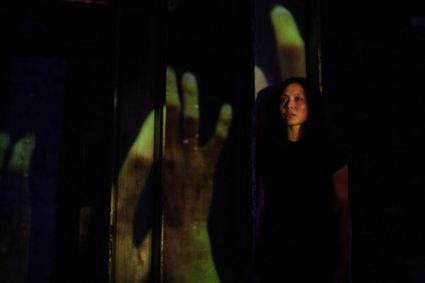
Weizen Ho, 2011, Blacktown Performing Arts Residency
photo Mayu Kanamori
Weizen Ho, 2011, Blacktown Performing Arts Residency
Blacktown Arts Centre Residencies
Blacktown Arts Centre is calling for applicants for their residency program which offers both funded (up to $5000) and unfunded opportunities (ie in-kind space only). Applications are open to residents in the Blacktown area or artists who can demonstrate a connection to the region.
Applications close 30 Sept; http://www.artscentre.blacktown.nsw.gov.au/performance/2014-performing-arts-residencies.cfm
Fisher’s Ghost Prize, Campbelltown Arts Centre
The organisers of the Annual Fisher’s Ghost Prize are calling for entries from artists around Australia. There are a number of entry categories including Contemporary, Photography, Sculpture, Drawing and MACABILITY (for artists with a disability). The overall winner receives $20,000 and their work is acquired for the Campbelltown Art Gallery’s permanent collection. The exhibition will take place 2 Nov-16 Dec.
Entries due 4 Oct, 2013; http://www.campbelltown.nsw.gov.au/FishersGhostArtAward
House Proud 2014, Boroondara City Council
Applications are now sought from independent artists and companies to present performance activities (theatre, dance, music, comedy or cabaret) between February and June 2014 at the Kew Court House in Melbourne’s north-east. Successful applicants will receive access to the venue and a range of associated services free of charge.
Applications close 30 Sept; http://www.boroondara.vic.gov.au/our-city/arts-culture/kewcourthouse/house-proud
version 1.0 masterclass
Carriageworks and performance company version 1.0 and are presenting a masterclass in performance devising. Version 1.0 are renowned for their highly political and frequently humorous investigations into Australian politics and culture (for examples see RT113, RT105, RT81; RT68).
Masterclass 19 Oct, and bookings now open.
http://www.trybooking.com/Booking/BookingEventSummary.aspx?eid=60167
Still in the loop
Melbourne White Night
Submissions close 1 Oct 2013
http://whitenightmelbourne.com.au/
Summer Studio Residency, Penrith Regional Art Gallery
Applications due 14 Sept
http://www.penrithregionalgallery.org/
Fast+Fresh Dance, FORM Dance
Registration closes 14 October
http://form.org.au/2013/01/fastfresh-dance-2/
FlickerFest call for entries
Deadline for Australian & International entries 11 Oct; for GreenFlicks & FlickerUp 18 Oct
http://www.flickerfest.com.au/
Workshops & Residencies, Lucy Guerin Inc
Applications for studio residencies & workshop places due 23 Sept
http://www.lucyguerininc.com/studio-projects/Studio_Residency; http://www.lucyguerininc.com/studio-projects/Hotbed
Next Generation Placement, ASSITEJ
Deadline for applicants 30 Sept
http://www.assitej-international.org/next-generation/
Forever Now
Applications open until June 2015
http://forevernow.me/
Selected Australia Council Grants
for full list see http://www.australiacouncil.gov.au/grants
Music: Fellowships – 17 September 2013
http://www.australiacouncil.gov.au/grants/2013/music-fellowships
Music: Project Fellowships – 17 September 2013
http://www.australiacouncil.gov.au/grants/2013/music-project-fellowships
Music: Don Banks Music Award – 17 September 2013
http://www.australiacouncil.gov.au/grants/2013/don-banks-music-award
Music: Skills and Arts Development – Artist Development – 17 September 2013
http://www.australiacouncil.gov.au/grants/2013/music-skills-and-arts-development-artist-development-17-september
ArtStart – 23 September 2013
http://www.australiacouncil.gov.au/grants/2013/artstart2
Emerging and Experimental Arts – 4 October, 2013
http://www.australiacouncil.gov.au/grants/2013/experimental-arts-grants-4-october
RealTime issue #116 Aug-Sept 2013 pg. web
© RealTime ; for permission to reproduce apply to realtime@realtimearts.net
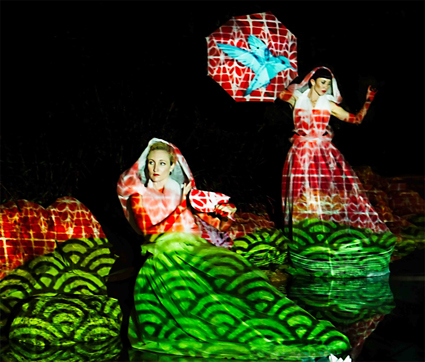
Leah Shelton & Lisa Fa’alafi, Tradewinds, Polytoxic
courtesy the artist
Leah Shelton & Lisa Fa’alafi, Tradewinds, Polytoxic
As the music for Polytoxic’s Tradewinds becomes more focused and takes on a simple piano melody, there is just enough sunlight remaining to make out the shape of two women in billowy white dresses walking on the surface of Darwin’s Waterfront Recreational Lagoon. These fairytale-like figures bend slightly to inspect a few of the many origami boats floating in the lagoon. Though they converge in the centre of their watery stage they don’t seem to notice one another as natural light gives way to the pale yellow and red projected onto their dresses.
Tradewinds is the work of Brisbane-based dance theatre company Polytoxic teamed with visual artist Samuel Tupou. By means of a submerged barge the two women seem to walk and dance on water while their elaborate dresses and the simple props they hold form screens for a dreamy laser show. This is an encounter between two women, perhaps two cultures, similar but distinct, brought together by the Pacific Ocean tradewinds.
There are times when the dresses are almost perfectly reflected in the water. The figures are bathed in liquid light that changes from purples and greens through to yellows and blues. The dresses and the umbrellas provide a surprisingly flat plane on which to project crisp and clear images of pigs, dragonflies and Polynesian patterns. Palm trees grow on the dresses and we see the dancers at times react to these animated figures.
The performance is set to a simple musical arrangement. Beginning with piano and xylophone it replicates the naïve demeanour of the characters interacting with their new surroundings. There is a bubbly, almost underwater theme to the melody that creates a feeling of levity and wonderment. That sound moves to a faster tempo and a more complex melody when the women, who have been moving on their own, reach out to touch, and as if in a mirror reflection, trace the other’s movements.
At one point the women exchange the hand-held fans they flutter, suggesting similar but distinct cultures. Though the fans are different shapes, they perform the same function and are used with ease. Similarly, the two move together in the same direction but never quite make a perfect reflection of the other until the motion and the music slow to end the show in the blue light of imagined Pacific waters.
To properly see the laser projections, the large crowd needed to gather in front of the performance. Some form of elevated seating might have enabled more people to enjoy it. Those fortunate enough to find a good spot were treated to a dreamy and ethereal spectacle worthy of a fine location.
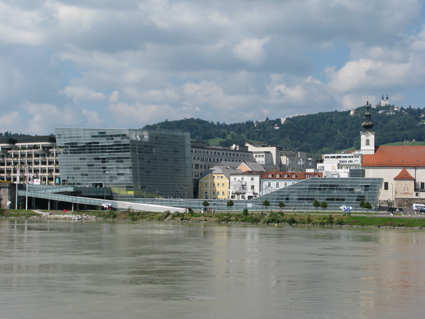
Ars Electronica Centre on the Danube, Linz
photo Gail Priest
Ars Electronica Centre on the Danube, Linz
It’s that time of year again, the first week of September and you are in Linz for Ars Electronica. Let’s imagine you’ve been lucky enough to win a Golden Nica. You’ve arrived, installed your work at the O.K. (say oh-kah) Offenes Kulturhaus for the Cyberarts Exhibition. Everything’s working, you’ve done your interviews with ORF (Österreichischer Rundfunk/Austrian Broadcasting), been through the Ars Electronica Centre , met up with some friends at the Futurelab and now what? What else is there to do in Linz other than Ars Electronica? It does appear to have embraced almost every cultural venue in the city. Well the simple answer is enjoy as much Austrian cuisine and lifestyle as possible.
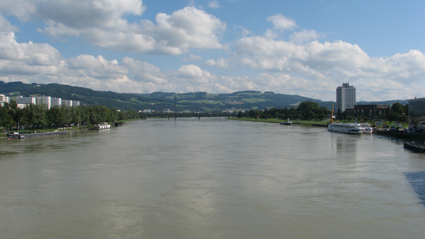
The Danube, Linz
photo Gail Priest
The Danube, Linz
Walk whenever you have time through the most charming areas of the city: Herrengasse, Altstadt, Hauptplatz and along the Danube. A Linzer looking to relax might start the day with a Viennese style breakfast. Perhaps Traxlymayr on the Promenade for those living the high life, or Café Meier on Pfarrplatz.
A brief but essential note on coffee for the Australian traveller. Ordering a café latte will get you something quite unlike what you love from your local coffee house. Don’t go there! A long black is called verlängeter (fer-leng-e-ter), a cappucino is still a cappucino and my recommendation for the would-be latte drinker would be to try a Wiener Melange.
A walk along Herrengasse can be recommended at any time of the day and close to the Dom (St Mary’s Cathedral) you’ll find Jindrak Conditorei, the one cake shop in town that can claim the right to the Original Linzer Torte (I use blind faith as a basis for this claim since every other cake shop in Linz claims to own the original recipe dating from 1653). Their other cakes are also amazing with unlimited combinations of sponge cake and flavoured creams. Definites to try are Apfelstrudel and Sacher Torte in any Austrian establishment. The Dom itself is magnificent inside and in recent years has hosted a night-time program of sound works during the festival.
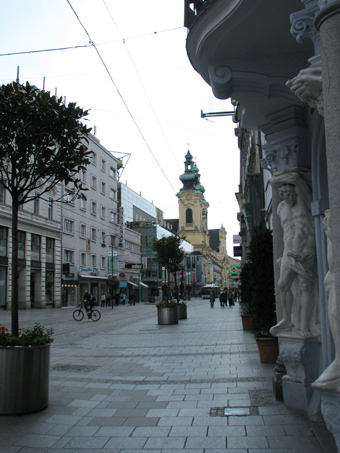
Linz
photo Gail Priest
Linz
Wander up to the Linzer Schloss. In fine weather the Schloss Cafe garden is a fine place to have a light meal or drink and look out across the Danube and the Nibelungen Bridge. If it happens to be Friday morning, there is a little farmers’ market on the Hauptplatz, a great place to buy yourself some bread and fresh produce.
If the weather happens to be awful and/or your hangover from celebrating your Nica for the third night in a row happens to be too much, then a visit to the Parkbad Sauna Oasis is just the ticket. A swimming pool, indoor and outdoor in summer, combined with an excellent array of saunas and spa baths, makes a good comedown after all your hard work.
For Dinner there are many options. If you have fine weather then find your way to Schindler’s Heuriger and order a Schindler’s Jauser. It’s perfect for two people, a simple meal of sliced cold meats, fresh brown bread, a few special dips like Kartoffelkäse (potato cheese) and a schnapps in the centre. Combine that with a Wieselberger beer or two and you’ll be feeling fine. A local wine festival has also wedged itself into the festival weekend in the Altstadt (old town) and this makes for a romantic evening sipping fine wines; try the Zwiegelt.
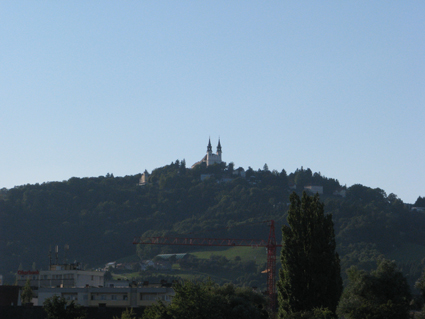
Pöstlingberg, Linz
photo Gail Priest
Pöstlingberg, Linz
Alternatives, keeping with some Austrian traditions, include making your way to Gelbes Krokodil at the O.K. Platz or to Alte Welt off the Hauptplatz. Wirt am Graben (on a street called Graben) is really great if you can get a table, or embrace the beer hall tradition with the Stieglitz on Landstrasse. Cubus atop Ars Electronica always serves an excellent meal with a great view. If you want to feel super special however, take the tram up to Pöstlingberg (that little Disney looking church overlooking Linz) and dine at the Pöstlingberg Schlossl with a table on the balcony. You’ll spend your hard earned Nica money, but you’ll eat and drink in fine style.
And if after all that coffee, food, cake, wine, meat, beer you still want more and all those ice cream stands on the hauptplatz are tempting you, don’t try them yet. Walk around to Eisdieler on the Promenade and enjoy one of the best ice creams ever. Seriously!
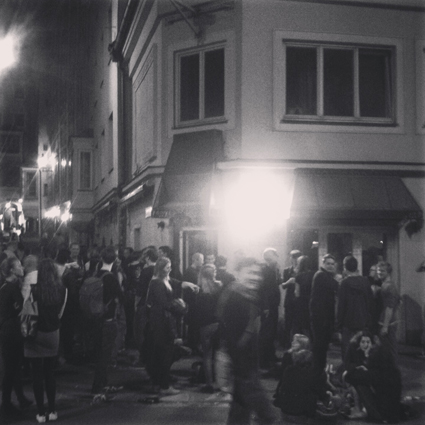
Rote Krebs, Linz
photo Matthew Gardiner
Rote Krebs, Linz
If you’ve slept the whole day, you’re just waking up at night time and you’re back in festival mode, the two bars that are a must for the festival goers are Strom on the main deck of Ars Electronica and the Roter Krebs across the river. Going back along the Landstrasse you’ll find a few other watering holes including Walkers on Hauptplatz, which serves good burgers, or the Chelsey on Domgasse, a little English pub serving Guiness on tap. Extrablatt on Spittelwiese also serves good burgers and is open late. Finally you should be seen at Solaris in the O.K. or, on the Saturday night of the festival, upstairs at the O.K. festival party.
—-
Matthew Gardiner has lived in Linz as an artist and researcher at the Ars Electronica Futurelab since 2011. He recently curated “Projekt Genesis: life out of the laboratory” at the Ars Electronica Center. You can find him in the festival program, usually giving a talk, or else out late with beer in hand; if you are an Australian in Linz don’t be a stranger. http://www.matthewgardiner.net/
Check out RealTime’s Media Art Archive for coverage of Ars Electronica over the last 19 years
Links
Ars Electronica Festival http://www.aec.at/totalrecall/en/
Ars Electronica Centre http://www.aec.at/
Offenes Kulturhaus http://www.ok-centrum.at/?q=en
Traxlymayr http://www.cafe-traxlmayr.at/
Café Meier http://www.cafe-meier.at/
Schindler’s Heuriger http://schindlers-heuriger.stadtausstellung.at/
Gelbes Krokodil http://www.krokodil.at/
Alte Welt http://www.altewelt.at/
Wirt am Graben http://www.wirtamgraben.at/
Cubus http://www.cubus.at/
Pöstlingberg Schlossl http://poestlingberg.at/
Eisdieler http://www.eisdieler.at/
Strom http://www.stwst.at/index.php?m=4&sm=1
Roter Krebs http://www.roterkrebs.net/
Walkers http://www.walker-bar.at/
Solaris http://www.solarisbar.at/
RealTime issue #116 Aug-Sept 2013 pg. web
© Matthew Gardiner; for permission to reproduce apply to realtime@realtimearts.net

Leah Shelton & Lisa Fa’alafi, Tradewinds, Polytoxic
courtesy the artist
Leah Shelton & Lisa Fa’alafi, Tradewinds, Polytoxic
Two women, dressed in identical voluminous white dresses, appear in the water at each side of the Darwin Recreation Lagoon—they float towards each other carrying small origami boats. Their easeful passage is disrupted as the women stumble, their boats dipping dangerously, the gentle ethereal music becomes dissonant and their glide momentarily jagged.
The dangers of sea travel is referenced, resonating with a northern Australian audience used to asylum seekers being turned away from their shores. The women meet but cannot work out how to greet, each performing ritual gestures that do not match.
Polytoxics’ performative outdoor installation Trade Winds depicts the meeting of women from different cultures. A dance work with contemporary pop aesthetic projections from Samuel Tupou, it is set to a rhythmic soundtrack of piano, electronica and bass hums. The women look identical, they wear matching dresses, carry the same umbrellas and mirror each other’s movements as vibrant projected patterns cover them. Is it deliberate that these supposedly different cultures appear to be mirror images of each other or is the audience watching from the beach the stranger? The narrative is loose in Trade Winds with the visual element as the main focus.
The women’s dresses and umbrellas form screens for the animated projections of the weird, wonderful and sometimes bizarre creatures and plant life they encounter in a strange land. The pair are in turns intrigued, amused and afraid of these highly coloured creations that run riot over their clothing—blue pigs, purple crocodiles, insects, hummingbirds, rapidly growing flowers and slightly oddly, what appeared to be a rainstorm of decapitated heads. Much of the dancers’ movement is restricted to ritualised arm and hand gestures and occasional exaggerated pantomime as they respond to the creatures, patterns and plants.
Following their meeting, both with each other and an alien culture, the women drift back to their sides of the lagoon and eventually out of sight—seemingly unchanged by their brief encounter.
For a visual work the overwhelming problem was the necessity for front-on viewing vital if one was to see the projections which were the mainstay of the piece. The audience sat in a semi-circle around the lagoon but only those sitting directly in front of the performers were able to see the animations.
The workshop prior to the event engaged the largely family audience with children making origami boats which carried their written dreams and hopes. These were internally lit and floated on the lagoon during the performance. This ‘message-in-a-bottle’ reaching out across the waters was powerful and poignant for a Darwin audience that is itself a cultural melting pot and only a few hours sail away from our Asian neighbours.
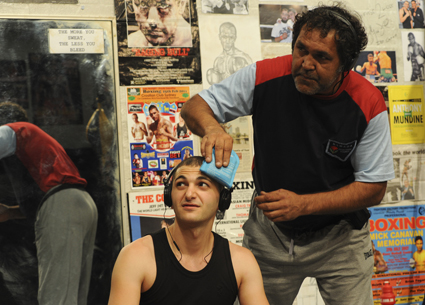
Mohammed Ahmad, Billy MacPherson, I’m Your Man
photo Heidrun Löhr
Mohammed Ahmad, Billy MacPherson, I’m Your Man
The sound of punches landing, grunts, shouted words of encouragement, background pop music and the smell of liniment hits you the minute you enter the slightly shabby gym (Brown’s Mart theatre transformed) to witness the world of the professional boxer.
For 18 months writer/director Roslyn Oades accompanied Featherweight fighter Billy ‘The Kid’ Dib as he prepared for the World Title. She recorded interviews with Billy and legendary boxers on the circuit and from this created an audio script which the actors listen to through headphones and faithfully reproduce—every stutter, pause, laugh, mumble. I’m Your Man is the third work in a trilogy exploring acts of courage using this headphone-verbatim technique.
The five performers, some playing two characters, train hard for the full 70 minutes of the show—real sparring, real chin-ups, real competitive skipping with ropes moving so fast you can’t see them. It is physically impressive but that is just one aspect of the show. The boxers’ stories reveal the pride, powerful loyalty and the drive that makes them want success so much.
It’s a violent world—“Its war… break that guys face…put him in a world of hurt”—contrasted with brotherly love and loyalty. John Shrimpton plays Wale ‘Lucky Boy’ Omotoso, a Welterweight boxer from Nigeria, who cries in the hospital for his sparring partner, the 2-year-old boy he killed with a punch to the head. Omotoso talks of street life back in Nigeria and how he had to fight to survive. He speaks softly about looking after his family and bringing his brothers to Australia, thanking God before he drops into a harder voice declaring that now he has to ‘keep doing what I’m good at” and belts the punching bag viciously.
The actors play across cultures. Shrimpton is not Nigerian but the exact reproduction of the recorded voice creates a strongly believable character irrespective of the actor’s own cultural background. Katia Molino plays across genders as CJ from London’s East End. CJ is a wild-eyed fighter you wouldn’t want to meet in a dark alley. He’s up on a charge of grievous bodily harm but wants to win then join the police force to “help others…kick that door in…wear that badge.” Despite his obvious violence he is a likeable character, full of charm and funny one-liners. This is the key to the production’s success: these boxers are three dimensional characters—we see their dreams, their fears and their vulnerability and, for people like myself who have not known the world of professional boxing, it is a fascinating peek into an alien environment.
Contrasting with the young hopefuls is the older boxing icon, the gravelly-voiced Gus Mercurio, played by Justin Rozniak. He sits on a stool in the corner of the gym speaking with a stutter about his early life. He is what the younger ones may become. He embodies the damage done from years of being hit—the punch-drunk “success” story.
I’m Your Man moves fluidly, counterpointing solos, duets and group scenes. The soundtrack provides moments of respite from the show’s direct address as the actors move into their own silent worlds preparing for the fight. We hear white noise, crowds roaring, punches landing hard and the boxers’ breathing amplified and slowed to a pulsing heartbeat. The lighting moves from harshly lit gym to a contained boxing ring surrounded by darkness echoing the single-mindedness of these men.
Billy stands in this square of light as he’s pumped up and prepared by his entourage: “you can do it Billy…love you bro…he can’t hurt ya Bill..”—the five actors hearing five voices simultaneously on their headphones. Then Billy is alone and ready to face his opponent.
I’m Your Man is a powerful work with an immediacy and gutsy realism created as much by the fact that the actors work hard to listen to voices in their ears as they’re performing as by the content. The usual theatre-going audience was gripped by the sheer physicality of it and the members of the local boxing club hooked into the theatricality. I’m Your Man delivered a winning punch.
Oscillation between deepening despair and jittery anxiety has been replaced by a sense of numb hopelessness in the last week of the 2013 federal government election campaign. If it weren’t for Crikey.com’s First Dog on the Moon and other doses of wisdom from that publication, The Conversation and Mungo McCallum in The Monthly, insanity might have ensued.
In contrast, the ABC’s ever-cautious entertainments, Gruen Nation and the tirelessly undergrad The Chaser, offer only mild relief. Perhaps one day we’ll have our own brave equivalents of Jon Stewart and Stephen Colbert. Meanwhile, with the polls having ‘determined’ the election outcome, hopelessness is slowly being usurped by fear of the election aftermath.
Peak panic
On the arts front, after all the hard yards peak organisations, companies, groups and individuals had put into debating the construction of the Creative Australia National Cultural Policy and the future of the Australia Council, a sense of impending doom has manifested late in the election campaign. Would the millions promised the arts via an expanded Australia Council be subject to an Abbott government’s austerity measures? [Among ‘austerity’ critics is US graduate economics student Thomas Herndon who famously revealed ‘austerity economics’ to be a fraudulent notion. Austerity has further weakened GFC-blitzed countries by pulling massive numbers of people out of economies that need empowered citizens, consumers and, not least, taxpayers. Queensland and New South Wales have already come to that Neoliberal party.] Despite Shadow Arts Minister George Brandis’ assurances that he’s not about to disappear the Australia Council, anxiety is widely felt in the arts community. We all know the Black Hole ruse only too well.
A “new arts coalition,” comprising Australian Major Performing Arts Group, Australian Performing Arts Centres Association, AUSDANCE, Media, Entertainment & Arts Alliance, Performing Arts Touring Alliance, Regional Arts Australia and Theatre Network Victoria has put it to the Coalition that the increased funding to the Australia Council be retained; all arts grant funding be fully indexed and the efficiency dividend dropped; national touring be increased; international cultural relationships developed; and the “industry connection with the education and training sector” be strengthened. If Abbott wins I imagine that the first of these requests is the only one likely to be met (pending the size of said ‘Black Hole’) but under what conditions, with Brandis already having declared the Council too Sydney and Melbourne oriented?
At the Blacktown Arts Centre in a one-off debate about arts funding with Arts Minister Tony Burke, Brandis declared, “Arts policy—and public money invested in the arts—have too often rewarded inwardness, mediocrity and political correctness, in the name of avoiding the elitist tag.” As Ben Eltham argued in his report on the debate in ArtsHub, Brandis’ aversion to ‘politically correct’ work doesn’t connect with his commitment to artistic freedom, his aversion to the inner city arts predominance doesn’t mesh with his high arts focus and his Hansard-documented proposal that “a direction by the Minister will in all cases prevail over a direction by the Board,” bodes ill in terms of ministerial influence—although the shadow minister said that it would not affect funding decisions.
Keep moving regardless: A Ministry of Culture
Griffith Review Editor Julianne Schultz at a Currency House (the publisher of Platform Papers) Art and Public Life Breakfast on 14 August adopted a long-term view, arguing for the establishment of a Ministry of Culture (instead of the arts being tossed from mixed portfolio to mixed portfolio government to government). She acknowledges that “The intersection of politics, authority and culture makes us nervous about being directed by the state,’ but, if we are to fully recognize the importance of culture “as an essential pillar…for any successful society or civilization” then we must do more than pay it lip service or having it “tacked on to another ministry.”
Schultz points to the way in which “thirty years ago [the environment] was not something that was valued, now it is.” Similarly, “the cultural economy is now significant; it reaches into everyone’s life every day…” She adds, “[D]epending on the personal commitment and interest of the Minister [for the Arts] is good, but not sufficient. It runs the risk of maintaining a patronage model, which rarely transcends subsistence.” A key advantage of having a Ministry of Culture says Schultz, is the opportunity it provides for negotiating with other ministries and departments, many of which invest in art and culture in various ways.” There is currently no cohesion:
“At the moment not even all the national collecting institutions answer to the same minister, heritage is in environment, cultural diplomacy and UNESCO are in DFAT, industry assistance for the creative industries is in innovation and climate change, tourism and sport are elsewhere, trade is not linked in any consistent way, broadcasting is in broadband and the digital economy, there are programs in education and health, and regional affairs funds the building cultural facilities and gives prizes for regional arts. And this is just the beginning. There are cultural activities and arts programs in immigration, Indigenous, communities and other departments—even defence spends hundreds of millions a year on cultural activities.”
Following the Government’s adoption of a national cultural policy and the re-shaping of the Australia Council, Schultz’s proposal is a welcome and logical one although it is hard to imagine a Coalition Government establishing a Ministry of Culture—the title likely to bristle with Soviet era connotations for some. Artists might worry that such a ministry could be tempted to exercise authority by intervening in the (already diminishing) arm’s length funding procedures and policy making exercised by the Australia Council and Screen Australia.
Julianne Schultz delivered her paper at a time when the arts were getting little if any traction in election campaigning. Every little bit counts, even this likely very contentious long-term proposal.
Arts overshadowed
I guess that many of us naively hoped that the arts were in a stronger and safer position as a result of the Creative Australia outcomes. Most of us have doubtless been focused on anxieties about health, education, employment, the low profile of the environment and the major parties’ race to the bottom (no moral compass needed) in dealing with the refugee issue in the most disgracefully self-serving campaign I can recall.
There was a glimmer of hope for TAFE in Kevin Rudd’s apparently off-the-cuff suggestion that the federal government take it over—doubtless too late for arts teachers in TAFE NSW and the hundreds of other TAFE teachers gone in Victoria while the country cries out for skilled labour.
Be afraid
The Coalition has charged the Labor Party with running a scare campaign about austerity cuts. Why shouldn’t we be afraid if we have such a limited idea of the extent of Coalition budget cuts?
The time has come for the public to demand that budgets be delivered no less than four weeks before the election date, and that they be costed by Treasury and not outsourced in a calculated, dogmatically Neoliberal attempt to convince the people of Australia that their Public Service is not trustworthy.
I do live in fear—of unnecessary and cruel austerity measures, for what they will do to the already poor, those who will join them, the unemployed and the marginally employed, many of them artists. I also worry about refugees, the environment, whoever wins, and I’m anxious about a B-grade NBN, unable to adequately serve businesses and especially the arts.
These accumulated concerns make it very difficult to think in terms of making an ‘art vote,’ not least because Labor and the Coalition’s responses to refugees and the environment are equally deplorable.
The arts vote
Artists and artsworkers I’ve spoken with agree that Labor has a comprehensive arts policy and welcome the $235 million Creative Australia already being allocated by the Australia Council and Screen Australia. The Coalition has no clear plan, let alone figures. Brandis says, “Whatever economies there are in the portfolio will be modest and will be apparent from the costings…I think people in the arts who listened to Mr Burke’s scare campaign will be very happy.”
From what I’ve been hearing, not a few artists—and their audiences—will vote Green where they can and spurn Labor in their disapproval of the party’s asylum seekers and environmental policies. They assume that whatever the Coalition does, much of what Labor has made will stay intact even if trimmed. Although censorious, elitist and inclined to interference (witness the Melba Foundation multi-million dollar direct funding scandal), LNP governments have had enough arts sympathisers among their supporters in the past to require them to maintain and even grow arts funding.
Should artists have lobbied more strongly during the campaign? Marcus O’Donnell writes in The Conversation, “the arts lobby seems to be missing in action this election, and secondly, given most publications have arts editors and arts sections this area ought to have been given more coverage.” The new “arts coalition” certainly came late on the scene, if with large representation, and Julianne Schultz’s proposal for a Ministry of Culture offered politicians a significant policy opportunity which, however, they were unlikely to pick up. As for media coverage Artshub and especially (as O’Donnell points out) The Australian, have provided recurrent coverage. But there has been little else.
Even had there been a more active arts lobby and wider media coverage of arts policies during the election campaign I suspect that ‘arts voters’ would, to put it bluntly, be voting about more than the arts. Art is about more than art.
Getting hysterical
As politics and opinion making become increasingly un-nuanced and absolutist, hysteria ensues. But having a good laugh or a copious weep, or both at once, can provide relief. My daily solace comes in the form of First Dog on the Moon. My favourite pre-campaign episode (among many like Night of the Living Rudd) features the retiring Black Caviar who insists, to everyone’s surprise, on having her lips sewn up (as did Mike Parr) in sympathy with imprisoned asylum seekers who had done just that. What First Dog says about Australian sporting and anthropomorphic inclinations, protest and politics, and performance art, is complexly funny and sad.
RealTime issue #116 Aug-Sept 2013 pg. web
© Keith Gallasch; for permission to reproduce apply to realtime@realtimearts.net
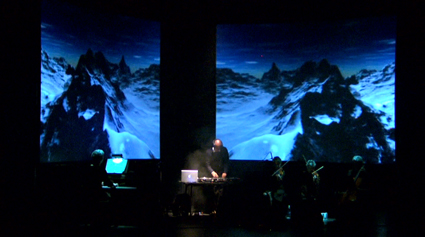
DJ Spooky
All rights reserved by New Mexico PBS
DJ Spooky
Curating Cities, NIEA
NIEA will be presenting a forum led by Paul Miller (aka DJ Spooky) as part of the ongoing Curating Cities project, researching how “the arts can generate environmentally beneficial behavioural change” (website). He will be discussing his participation in a sustainable art and music project at the Tanna Center for The Arts in Vanuatu. He will also be joined by Professors Douglas Kahn and Richard Goodwin.
NIEA (National Institute for Experimental Arts): Curating Cities, EG02, E Block, College of Fine Arts (COFA), UNSW, Paddington; 6 September 2013, 2.30-3.30pm; http://www.niea.unsw.edu.au/events/20130823/curating-cities-forum
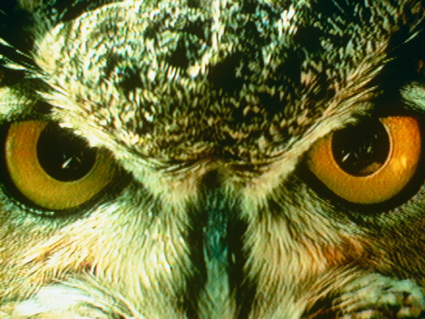
Bill Viola, I Do Not Know What It Is I Am Like, 1986 Videotape, colour, stereo sound; 89 minutes (still) © Bill Viola
photo Kira Perov
Bill Viola, I Do Not Know What It Is I Am Like, 1986 Videotape, colour, stereo sound; 89 minutes (still) © Bill Viola
ikono On Air Festival
ikono is a German-based organisation with an agenda to broadcast innovative art from across the world, both historic and contemporary. Across September they are presenting an “on air” arts festival viewed via a range of satellite and cable channels across the world, as well as an internet streaming option. The festival will focus on non-narrative and time-base art practices showing an enormous catalogue of works by 120 artists including Bill Viola, Alfredo Jaar, Anthony McCall and Brian Eno. As well as the festival they also produce mini-documentaries taking tours through great museums of the world—check out their website for a cornucopia of trailers and art-bites.
ikono On Air Festival, 6-29 September, http://ikono.org/festival/
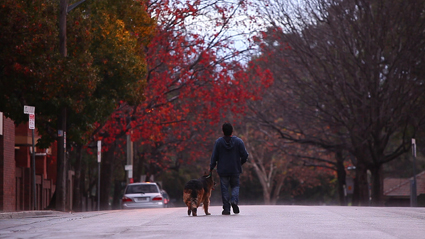
Post Life, ICE
Post Life, ICE
Based in Parramatta, Information and Cultural Exchange (ICE) has been running the Screen Transfusion project, a series of film and television production workshops for young people in Western Sydney. Some of these participants have then gone on to be part of the production team making the seven-part web series, Post Life. The ‘dramedy’ (dramatic comedy) follows John—a postal worker recently made redundant—as he tries to find a new path in life. Action is spiced up by Booboo, his daughter’s dog, an old lady sending mysterious packages and a love interest. The series will be launched with a screening at Riverside Theatres and will also be available online from 10 September.
ICE: Post Life, launch Riverside Theatres Parramatta, 10 Sept; http://ice.org.au/2013/08/web-series-trailer-post-life/
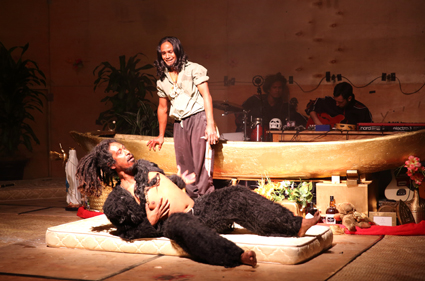
Doku Rai, Black Lung Theatre & Whaling C0mpnay, Liurai Fo’er and Galaxy
photo Tony Lewis, courtesy Adelaide Festival 2013
Doku Rai, Black Lung Theatre & Whaling C0mpnay, Liurai Fo’er and Galaxy
2013 Brisbane Festival
Read the small print in the 2013 Brisbane Festival program to find the really intriguing works. RealTime’s picks are, from Cairns, the magical Bonemap’s Terrestrial Nerve (11-14 Sept), their short free work Nerve Engine, (Sept 10, 11) where you help generate art [book online], Cut Snake (10-14 Sept), Insomnia Cat Came to Stay (24-28 Sept), Nicola Gunn’s Hello May Name Is (10-14 Sept) and MKA Theatre’s The Unspoken Word is Joe (10-14 Sept). Also in the program, the wonderful East Timorese-Australian collaboration Doku Rai, China’s Fight the Landlord, I Malvolio from the UK and Australia’s CASUS physical theatre.
Brisbane Festival, 7-28 Sept, http://www.brisbanefestival.com.au/
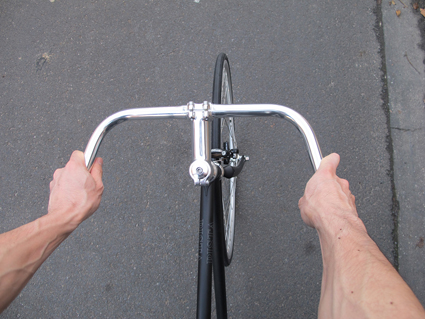
Akira Akira, Bicycle (a model for making-thinking), 2013, work-in-progress, Allegro Pista bicycle, mixed media
photo Sarah crowEST
Akira Akira, Bicycle (a model for making-thinking), 2013, work-in-progress, Allegro Pista bicycle, mixed media
arte magra: from the opaque, AEAF
Curated by Domenico de Clario and Mary Knights, arte magra: from the opaque exhibits the work/performances of 14 artists/collaborative teams. Arte magre—translated as lean or meagre art—builds on ideas explored by the Art Povera movement which preferenced conceptual pieces using simple, everyday materials. Many of the works will be site specific, such as Akira Akira’s Bicycle (a model for making-thinking), which can be hired from the BikeSA. Akira believes that making and thinking are as conjoined and co-dependent as the left and right leg, thus by riding his bike you experience this physical and conceptual balance. Other pieces include David Cross’s inflatable experiential sculptures; Joan Grounds’ documentation of shared walks with her dog; Jessica Lumb’s self-guided tour of the chewing gum on Hindley Street; and a site-specific performance by dancers Tony Yap and Janette Hoe. There will also be an accompanying symposium on 6 September.
arte magra: from the opaque, AEAF and various sites around Adelaide; 5 Sept-5 Oct, http://www.aeaf.org.au/exhibitions/ArteMagra.html
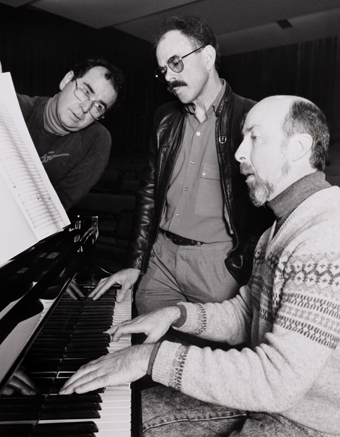
Ian McGrath, Peter Shepherd and David Vance in rehearsal, 1990, School of Creative Arts, University of Wollongong
30 years celebrations, Creative Arts, University of Wollongong
Congratulations to the School of Creative Arts, Wollongong University which is celebrating its 30th birthday. It’s no mean feat for a creative arts school to survive economic rationalism and the department will celebrate with a cocktail party, public performances, artist presentations and an exhibition, Transitions, featuring works by the staff, curated by Jelle Van De Berg.
Creative Arts Wollongong 30th Anniversary; Sept 9-11, http://lha.uow.edu.au/crearts/news/30thanniversary/index.html
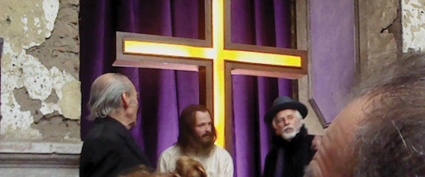
Dance of Reality, Alejandro Jodorowsky
Sydney Underground Film Festival
The Sydney Underground Film Festival is on again presenting over 30 of “the year’s most subversive, underground and cult films from around the world” (press release). The festival opens with Dance of Reality, the first film in 23 years by Chilean auteur Alejandro Jodorowsky—a psycho-magical interpretation of his life. Bookending the event is The Canyons written by Bret Easton Ellis, directed by Paul Schrader and starring Lindsay Lohan. In between, as well as other features, are shorts programs with titles such as LSD Factory, Lovesick, Reality Bites, Free Radicals and Ozploit.
Sydney Underground Film Festival, Factory Theatre, Marrickville, 5-9 Sept; http://suff.com.au
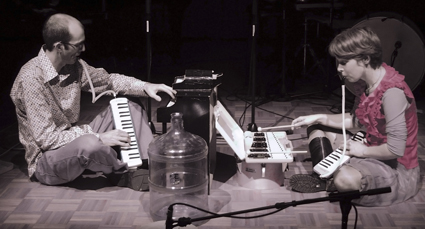
Clocked Out Duo
Melbourne Recital Centre
Diverse offerings at the Recital Centre this week. Clocked Out Duo perform Time Crystals (4 Sept) which premiered at Tura’s 25th birthday celebrations last year and of which Sam Gillies wrote, “The musical ground covered by the work is impressive. From the contemporary classical motifs of the opener, “Time Crystals,” to the jazz-like “Quantum Harmonics” and the rock-and-roll feel of “X-Ray Diffraction,” each work manages to balance its more distinctive sonic elements with cohesive structures that develop the work in exciting and unpredictable directions” (RT113).
On the same evening is Conversations with Ghosts, a collaboration between singer/songwriter Paul Kelly, composer James Ledger and recorder player Genevieve Lacy presented by the Australian National Academy of Music. The song cycle will feature texts by Kelly, Yeats, Tennyson, Judith Wright, Les Murray and Kenneth Slessor (4 Sept). Then riding high after his Festival of Slow Music (see last weeks in the loop), Adam Simmonds will perform with Wang Zheng Ting, master of the sheng, a Chinese mouth organ (7 Sept).
Various 4-7 Sept, Melbourne Recital Centre; http://www.melbournerecital.com.au/
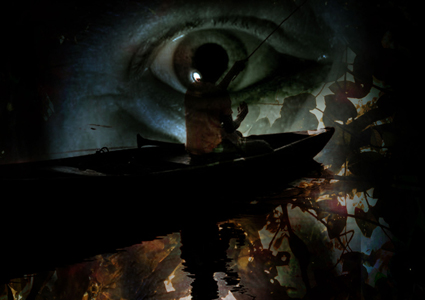
The boat goes over the mountain, Happy Dagger Theatre
The boat goes over the mountain, Happy Dagger Theatre
To make his film Fitzcarraldo, Werner Herzog faithfully recreated the titular rubber baron’s attempt to pull a steamship over a mountain in Peru. This new work, written and performed by Andrew Hale, pits his own experiences in Peru against Herzog’s, adding terrifying doses of the hallucinogen ayahuasca (yagé) used in shamanic rituals.
Happy Dagger Theatre, The Boat Goes Over the Mountain, Perth, 10-28 Sept, http://blueroom.org.au/events/the-boat-goes-over-the-mountain/
Still in the loop
Windows to the Sacred, S.H. Ervin Gallery
presented in association with Buratti Fine Art; 30 Aug-29 Sept
http://www.shervingallery.com.au/
Moogahlin Performing Arts, This Fella, My Memory
Carriageworks, 4-7 Sept
http://www.carriageworks.com.au/
Malthouse’s Helium
Little Ones Theatre, Salomé, 30 Aug-14 Sept
Smack! Bang, City of Shadows, Rachael Dease, 21 Sept-5 Oct
http://www.malthousetheatre.com.au/helium-2013/
In Confidence: Reorientations in Recent Art, PICA
31 Aug-13 Oct
http://www.pica.org.au
RealTime issue #116 Aug-Sept 2013 pg. web
© RealTime ; for permission to reproduce apply to realtime@realtimearts.net
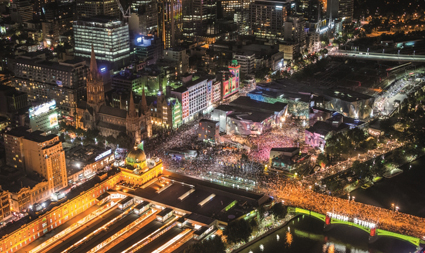
White Night Melbourne 2013
courtesy of the Victorian Major Events Company
White Night Melbourne 2013
Melbourne White Night
The White Night (Nuit Blanche) began in Paris in 2002—for one night, dusk till dawn, major arts institutions open their doors and culture fills the streets. In 2013 Melbourne joined 22 other international cities to present this 12-hour cultural extravaganza and now they’re planning the 2014 edition. They are calling for expressions of interest from musicians, visual and performing artists to infiltrate the centre of Melbourne on 22 Feb, 2014
Submissions close 1 Oct 2013; http://whitenightmelbourne.com.au/
Jump Mentoring
The Australia Council’s Jump mentorship applications close soon. Mentees can apply for up to $10,000 (solo artist) or $20,000 (group) to assist with professional and creative development. The program also involves an intensive in Feb 2014 where all mentees meet up for further networking, skills development and discussion.
Deadline 9 Sept; http://www.australiacouncil.gov.au/grants/2013/jump
Summer Studio Residency, Penrith Regional Art Gallery
Penrith Regional Art Gallery has announced an inaugural summer residency for an early career artist. The spacious Sonia Farley Studio (52sq metres) is available for a six-week period (non-residential) 2 Dec-10 Jan. At the conclusion the artists will make a presentation and have the opportunity to propose their work for the Artist Board program.
Applications due 14 Sept; http://www.penrithregionalgallery.org/
Fast+Fresh Dance, FORM Dance
Fostering young dancers and choreographers, Form’s Fast+Fresh Dance competition is open to artists 21 and under. Works must be five minutes or less and all styles are welcome. Awards will be given for Most Outstanding Choreography, Best Male and Female Dancer, Best Solo, Best Duet and Best Group and People’s Choice Award.
Registration closes 14 October; http://form.org.au/2013/01/fastfresh-dance-2/
FlickerFest call for entries
Flickerfest, celebrating its 23rd year, has opened its call for short films (under 35mins) for the 2014 competition. Categories include Australian, International, Documentary, GreenFlicks (environmentally focussed) and FlickerUp (for high school and primary students) with awards for Best Short, Best Animation and Best Australian Short.
Deadline for Australian & International entries 11 Oct; for GreenFlicks & FlickerUp 18 Oct; http://www.flickerfest.com.au/
Still in the loop
Workshops & Residencies, Lucy Guerin Inc
Applications for studio residencies & workshop places due 23 Sept; http://www.lucyguerininc.com/studio-projects/Studio_Residency; http://www.lucyguerininc.com/studio-projects/Hotbed
Critical Path Responsive Residencies
Deadline for Responsive Residencies 9 Sept; Research Room residencies no deadline, subject to availability; http://www.criticalpath.org.au/documents/2014_ResponsiveProgram_GuidelinesforApplying.pdf
Next Generation Placement, ASSITEJ
Deadline for applicants 30 Sept; http://www.assitej-international.org/next-generation/
Forever Now
Applications open until June 2015; http://forevernow.me/
Selected Australia Council Grants
for full list see http://www.australiacouncil.gov.au/grants
Community Partnerships: Projects – 6 September 2013
http://www.australiacouncil.gov.au/grants/2013/community-partnerships-projects-6-september
Community Partnerships: Cité Residency – 6 September 2013
http://www.australiacouncil.gov.au/grants/2013/community-partnerships-cite-residency
Community Partnerships: Career Pathways – Structured Mentorships – 6 September 2013
http://www.australiacouncil.gov.au/grants/2013/career-pathways-structured-mentorships-community-partnerships-6-september
Community Partnerships: Projects with Public Outcomes – 6 September 2013
http://www.australiacouncil.gov.au/grants/2013/community-partnerships-projects-with-public-outcomes-6-september
Festivals Australia – 6 September 2013
http://www.australiacouncil.gov.au/grants/2013/festivals-australia-6-september
JUMP Mentoring – 9 September 2013
http://www.australiacouncil.gov.au/grants/2013/jump
Music: Fellowships – 17 September 2013
http://www.australiacouncil.gov.au/grants/2013/music-fellowships
Music: Project Fellowships – 17 September 2013
http://www.australiacouncil.gov.au/grants/2013/music-project-fellowships
Music: Don Banks Music Award – 17 September 2013
http://www.australiacouncil.gov.au/grants/2013/don-banks-music-award
Music: Skills and Arts Development – Artist Development – 17 September 2013
http://www.australiacouncil.gov.au/grants/2013/music-skills-and-arts-development-artist-development-17-september
ArtStart – 23 September 2013
http://www.australiacouncil.gov.au/grants/2013/artstart2
RealTime issue #116 Aug-Sept 2013 pg. web
© RealTime ; for permission to reproduce apply to realtime@realtimearts.net
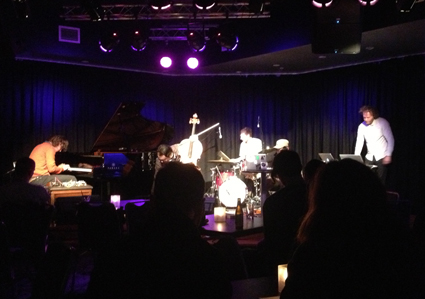
Tangents
photo Gail Priest
Tangents
The New Music Network soiree in the Sound Lounge starts when Sam Gillies, the electronic half of Cycle ~440, issues from his laptop a dirty sonic remnant. It has just enough timbre intact to be recognisable as something that might emanate from the currently silent piano on the corner of the stage.
After a meditative while he’s joined by Kevin Penkin whose cleanly placed real-time piano notes are sampled by Gillies—he catches them, hanging on to their tails, extending, bending and shredding them. The piano notes begin to accumulate forming rippling figures chased by electronic spectres.
Cycle ~440 offers a complex approach to the electro-acoustic relationship. While electronic instruments so frequently deliver sustained drone and continuity, it’s the fluidity of the piano that hold this music together. Gillies is a master of restraint (or so it seems), delicately adding staticky beds and glitchy half-beats wrestled from the live sampled piano, or sharpening the jingle-jangle of tones. Penkin surfs the waves—both those emanating from his own playing in the moment and the delayed and dirtied version of himself. His harmonic predilections are sweet and melancholic, reminiscent of surging film scoring. (He cites a love of Japanese anime music in the program notes.)
Then Gillies lets rip—a blast of noisy static, out of nowhere, then gone. While there has been grit in the under-layers, this discharge of detritus is disturbing not just for its suddenness but its brevity. This occurs one or two times more within the set. It seems harder to contextualise these eruptions of noise within the otherwise very pretty frame, than if noise were to swallow the niceness whole for the remainder of the piece. I’m off-balance, both wanting more noise to create a new context, yet feeling resentful of its intrusion.
The set concludes with Gillies, back to his genteel self, spinning out a tiny, sweet harmonic drone suspending the final utterance of the once more silent piano. It’s been a beautiful ride, and while I’m not totally convinced by the ruptures, I’m interested in their power to perplex my structural expectations.
Headlining the evening is Tangents, a veritable supergroup for the exploratory music lover: Adrian Klumpes (Triosk) on piano and electronics; Peter Hollo (Four Play/Raven) on cello and electronics; Ollie Bown (Icarus) on computers; Shoeb Ahmad (guitar, vocals, computer) and Evan Dorrian (drums) both from Spartak. True to their name they play a meandering, tangential free jazz with enough harmonic confluences and electronic kinks to keep everyone happy.
As often happens with this style it starts minimally with Klumpes playing simple chords in mid and low registers, with just a whiff of delay and dirt. Dorrian finger-flicks his tom and issues spatters from his cymbals, while Hollo emits mournful ‘screaks’ from his cello. There’s a remarkably early peak as they all find each other, the rhythm section locking into tit-for-tat syncopation.
What’s particularly interesting about this group is how easily the alliances shift: a brief tonal coalition between Klumpes and Hollo creates satisfying warm harmonics; Bown and Ahmad’s electronic squelches intermingle to become a textural undertow; Klumpes and Dorrian come together with jazzy jibes and angular phrases that propel the action. These connections allow the music to develop contours often missing in this crescendo oriented form. This is a music of coming together and falling apart but with someone always ready on the ground to move things forward.
In contrast to their first section the second starts with everyone smashing it out in a free-jazz noise assault until Klumpes and Dorrian ground everyone again with a groove. Bown and Ahmad maintain a mild scream of noise and Dorrian provides a skittering coherence. Without noticing the shift they are playing faster and faster, reaching a well-earned final crescendo and succinct wind down to finish.
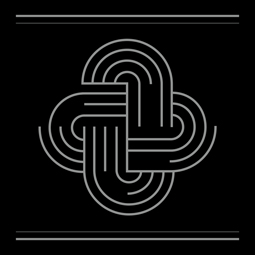
Tangents I, hellosQuares recordings
This gig was also the digital soft-launch (the physical product still in transit at the time) of Tangents’ debut album on Ahmad’s own label hellosQuares. While it was recorded in 2010 when the group was just forming, the current style is well represented, comprising five tracks each quite different in tone and approach—both spacious and complexly layered. While there might be a propensity to compare this group to The Necks, Tangents present a restless searching rather than the sustained single mindedness of that trio, however they manage to avoid a sense of attention deficit disorder often prevalent in this kind of music. Both live and recorded, Tangents offer a music of consensual diversions that makes for pleasantly discursive listening.
New Music Network: Cycle ~440, Sam Gillies, Ken Penkin; Tangents, Ollie Bown, Peter Hollow, Shoeb Ahmad, Adrian Lim-Klumpes, Evan Dorrian; The Sound Lounge, Seymour Centre, 1 Aug; http://www.tangentsmusic.com/; http://www.newmusicnetwork.com.au/
See RT116 giveaways for copies of the New Music Network Sampler.
RealTime issue #116 Aug-Sept 2013 pg. web
© Gail Priest; for permission to reproduce apply to realtime@realtimearts.net
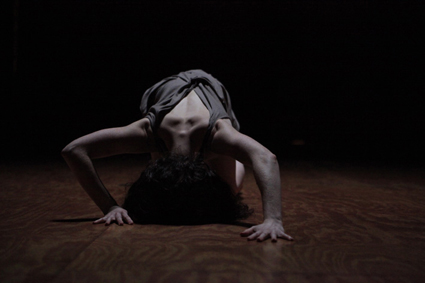
Blizzard, Nat Cursio Co
photo Rachel Bernhaut
Blizzard, Nat Cursio Co
Nat Cursio has written that Blizzard, her latest work for three dancers, presents “animal/human bodies” as “acute listening devices” proposing “a reminder of the delicacy of an ecosystem…a tribute to the ongoing capacity of animal life to…adapt.” At a glance this is a compelling premise for meaningful work and Blizzard does yield some exquisite moments, but as the attempt to translate bodies into devices might suggest, it is not without risk and confusion.
The show opens with confidence and an entrancing sensorial scheme. We are seated in a circle and asked to keep our eyes closed for the initial 10 minutes: a prompt that transforms the vast Newport substation into a nerve-tingling and purely aural field. Sounds are born in the darkness: body-generated, mingling with the whoosh and rumble of nearby trains; sporadic squishing; a rhythmic shuffle of someone—something—prowling about. Alert and somehow prepared by a slightly fearful awe, we open our eyes. The image before us holds something of the sublime.
Head down, the nape of its neck exposed, hair dragging over the floor, a dancer/creature advances in hypnotic slowness into the circle’s centre and out. Its lithe muscles ripple under lunar light; its palms slap the floor; its husky, bronchial purr is in equal parts sleepy, menacing, sensual. What creature is this?
A biped with searching feelers follows, then the intricate undulations of some kind of grub, both with faces averted downward. The enchanted focus of a nature documentary is engendered here. The creatures convince us, with their reconfigured anatomies. At best, we forget we are watching people (then remember); a sensibility beyond the confines of our own species may arise. It’s a beautiful spell, but soon broken.
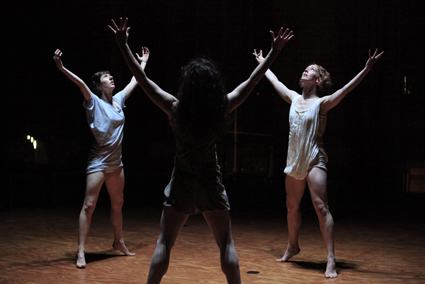
Blizzard, Nat Cursio Co
photo Rachel Bernhaut
Blizzard, Nat Cursio Co
The three dancers return to the circle—heads lifted, bipedal—and attune to a series of partly synchronised moves: tip-toed, sideways shuffles; pumping elbows; adjustments of footing; full-bodied flourishes with raised legs. There are synchronised gasps too and the timing is impeccable, but the vocabulary is often more mechanistic than organic, laden with nuances that conflict and confuse. Whether these are now insects or mammals is irrelevant, the style itself is unclear: a cerebral medley that evolves very little beyond the rise of an anxious mood.
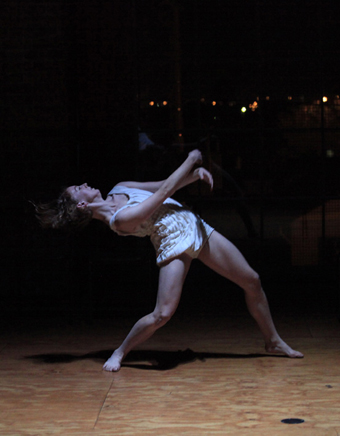
Blizzard, Nat Cursio Co
photo Rachel Bernhaut
Blizzard, Nat Cursio Co
What really aches in this piece is the dancers’ isolation, the absence of palpable relationships between them and toward us, the circled audience. Ecosystems operate through webs of symbiosis and reciprocity, cause and effect, yet in Blizzard we are presented with, at most, synchronisation, and otherwise with self-absorbed dancers who do not make contact by touch or gaze. Yes, they appear to be threatened, sometimes injured, perhaps endangered, but their neurotic loops of movement resemble the distress of captive animals, not the canny adaptation and outward-directed intelligence of the wild. This may be misguided anthropomorphism: more about the pain of the modern human condition than of creatures of the wild. Whatever the case, the cool distance inspires no affinity.
Just one moment toward the end unites the three dancers, as they gradually find and hold each other’s hands. But it is overdue, too slight and fleeting to mean very much. The great moments, in fact, are played at the start, through bold use of aural and sensory space, and the hushed arrival of that faceless, purring creature as it forges its path.
Blizzard, choreographer Nat Cursio, performers Alice Dixon, Melissa Jones, Caroline Meaden, The Substation, Melbourne, 30 July-4 August
See Philipa Rothfield’s preview of Blizzard in RT’s Online e-dition July 24
This article first appeared as part of RT’s online e-dition 4 Sept, 2013
RealTime issue #117 Oct-Nov 2013 pg. web
© Jessica Sabatini; for permission to reproduce apply to realtime@realtimearts.net















































































